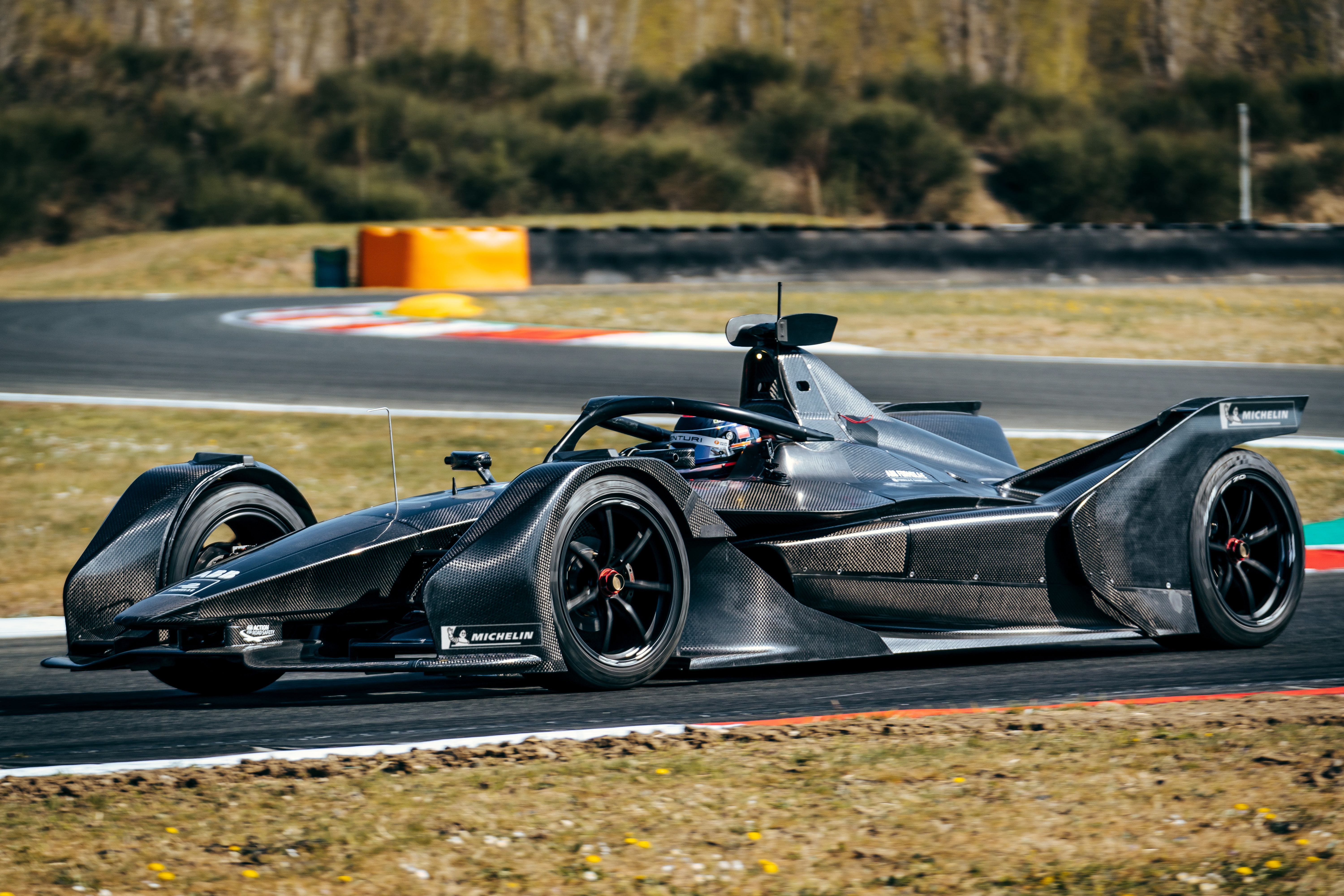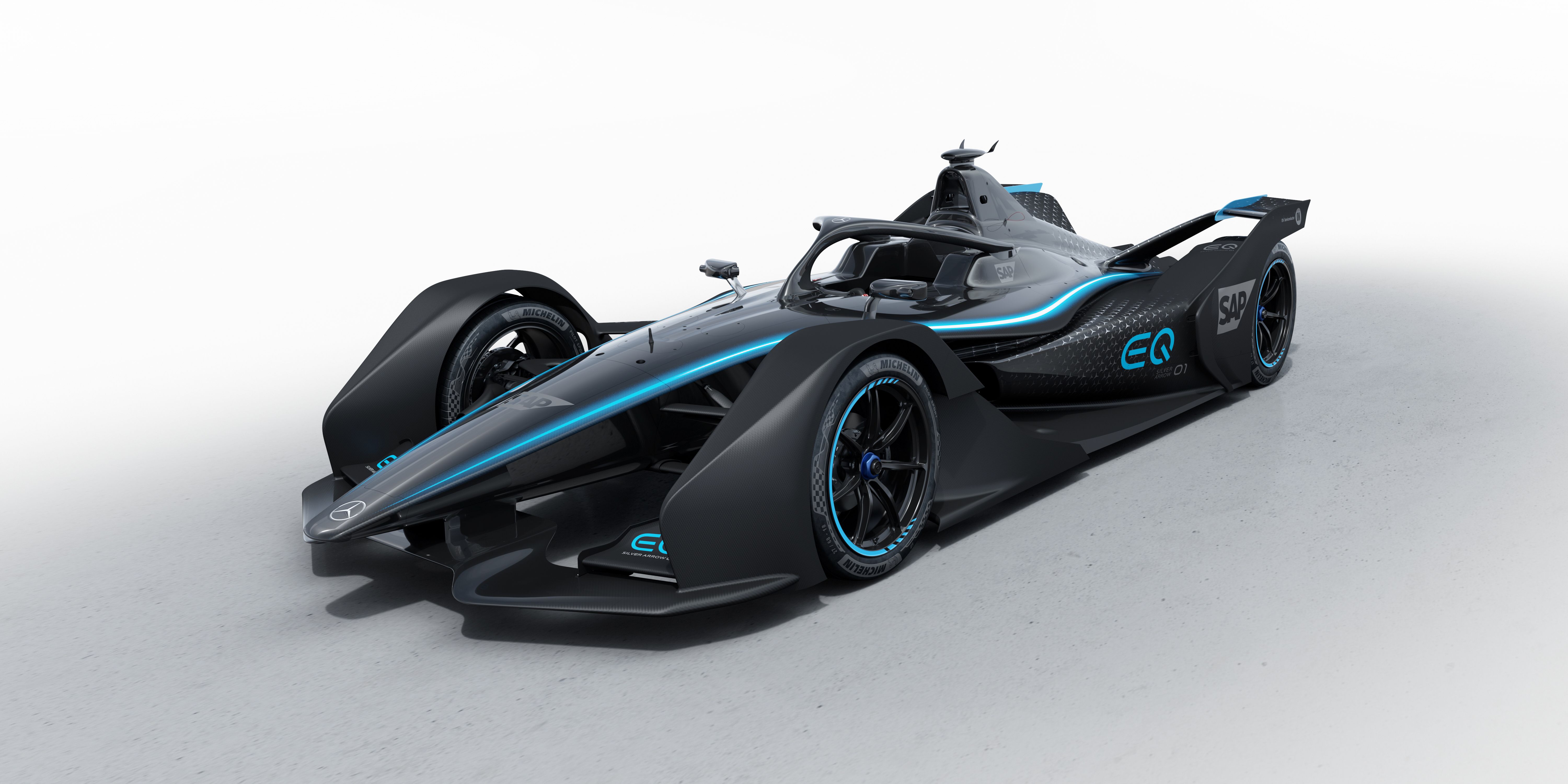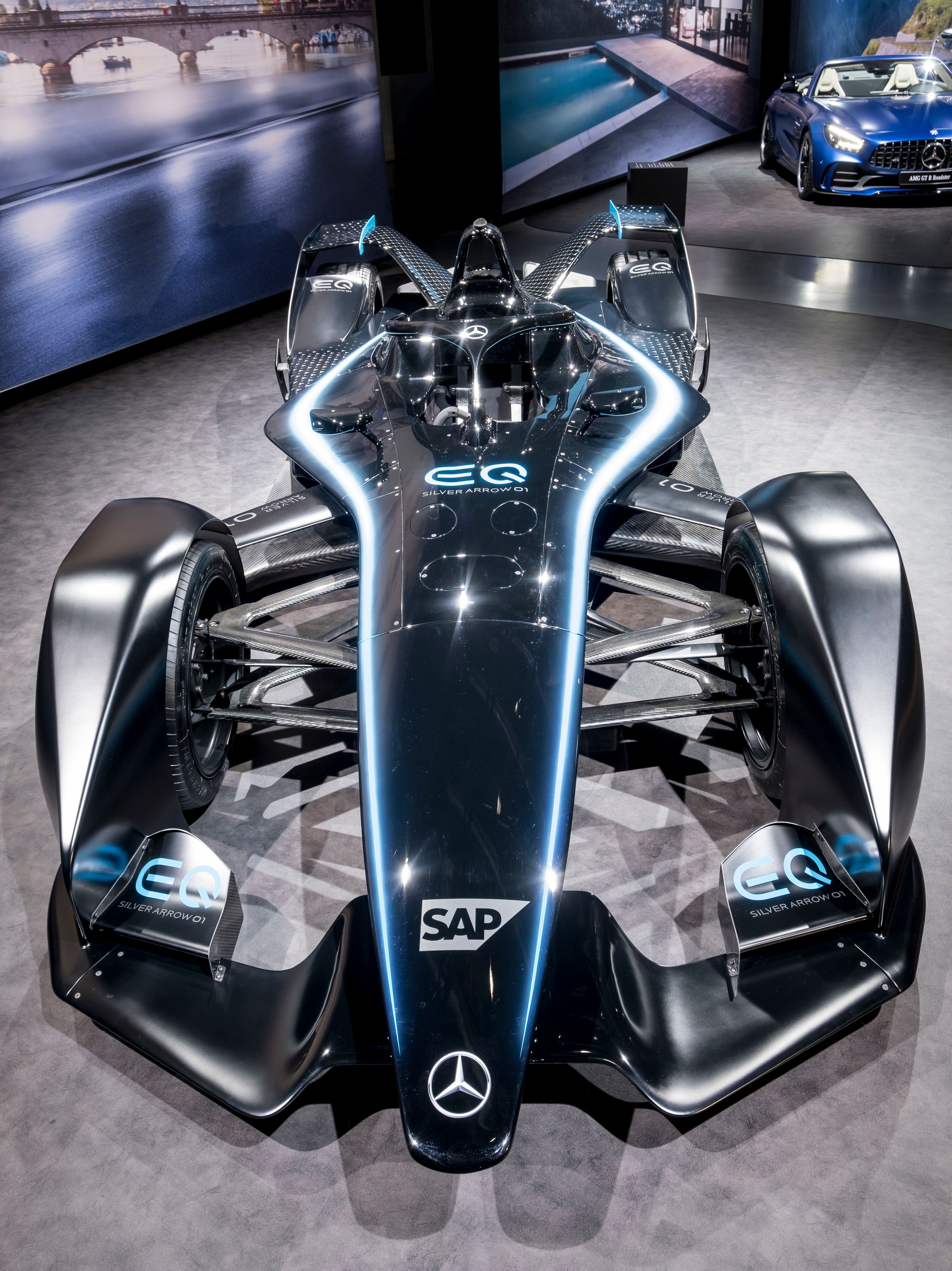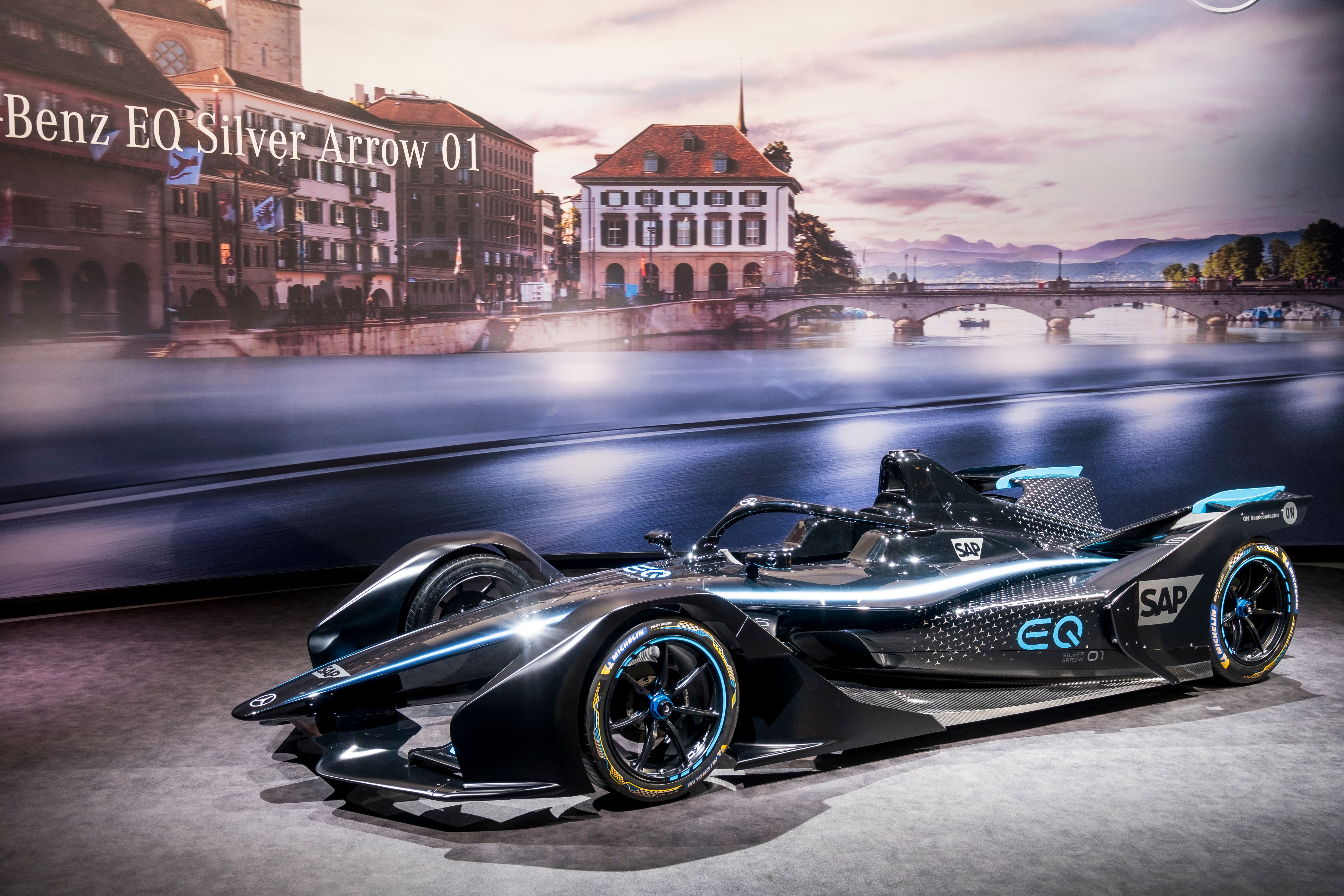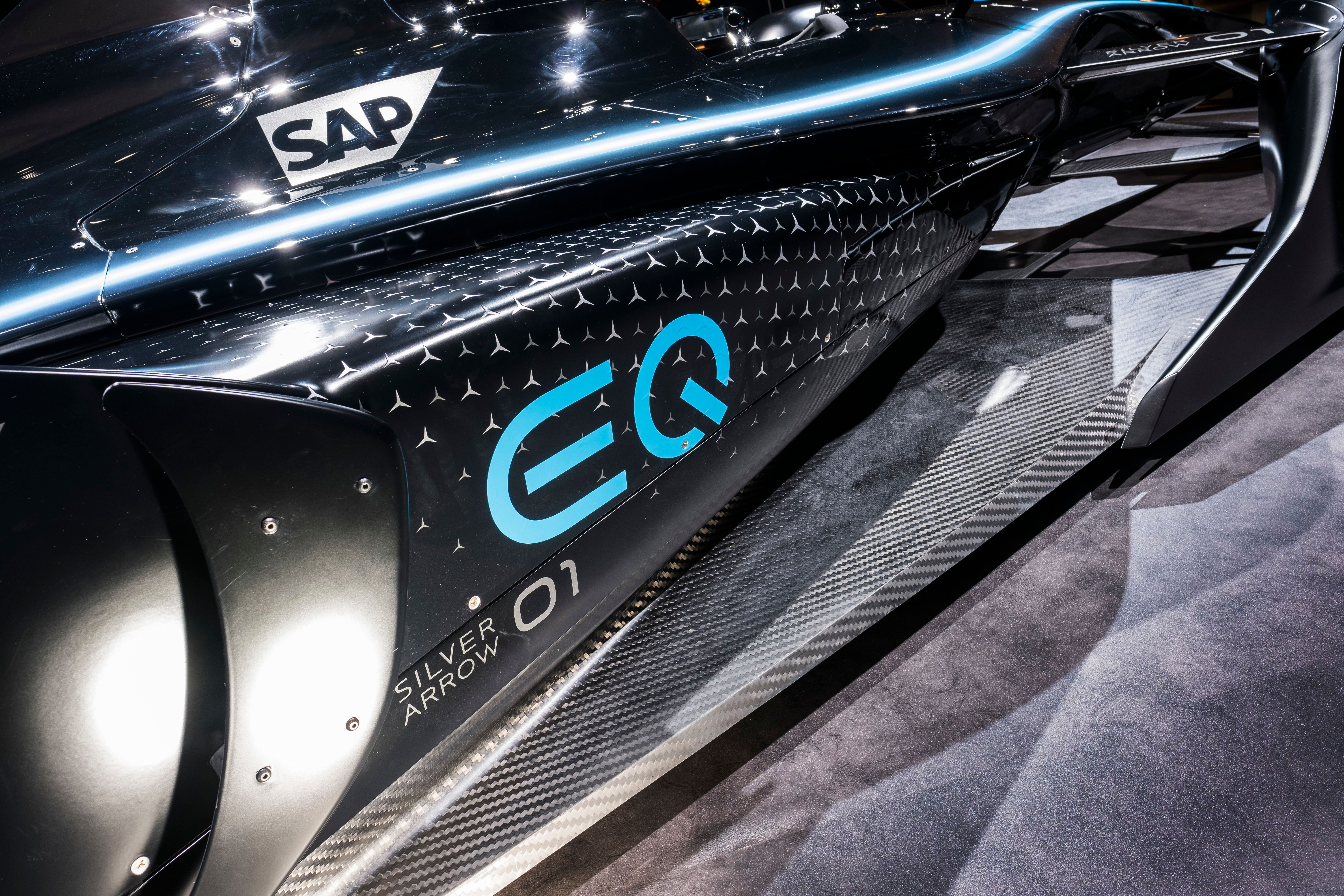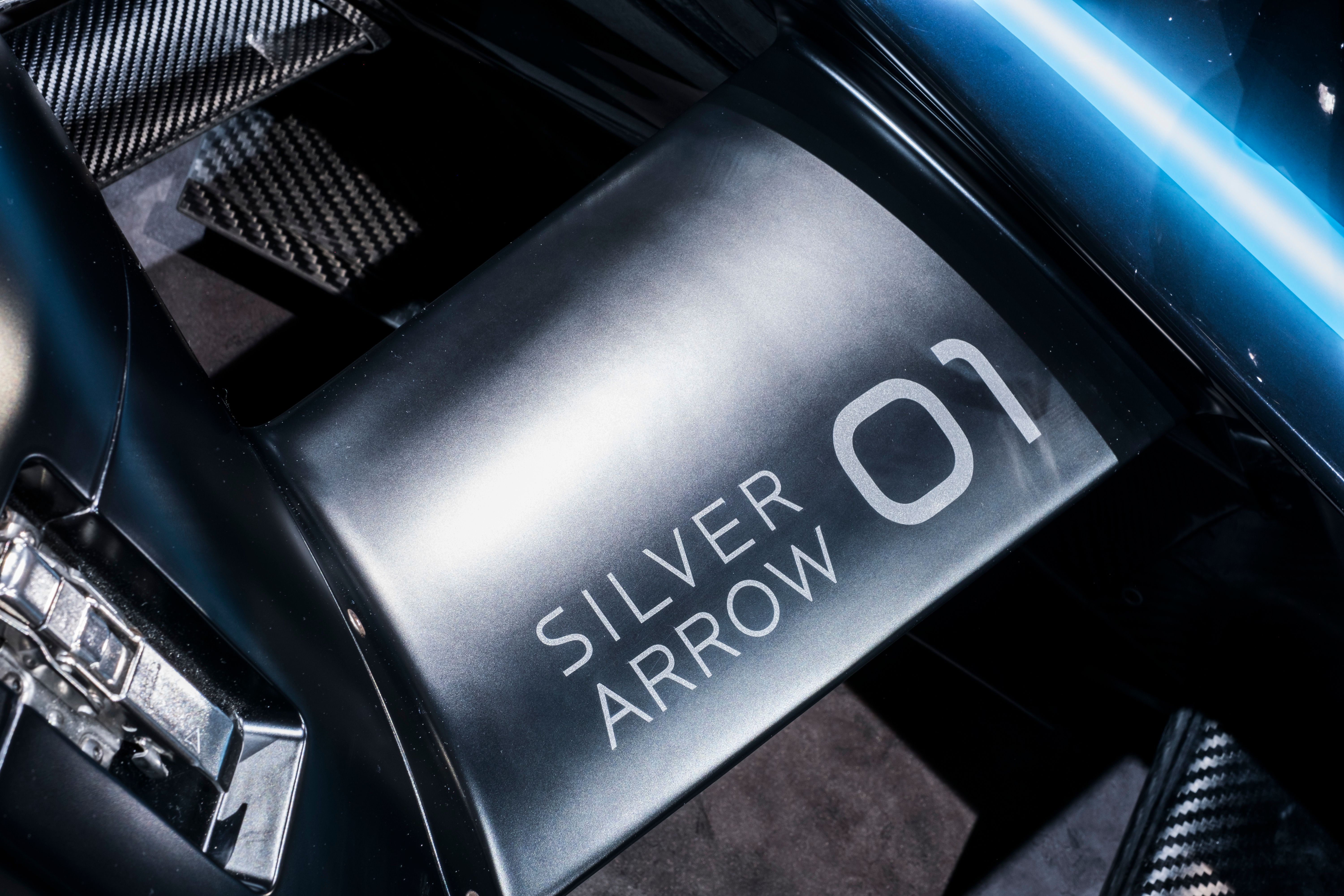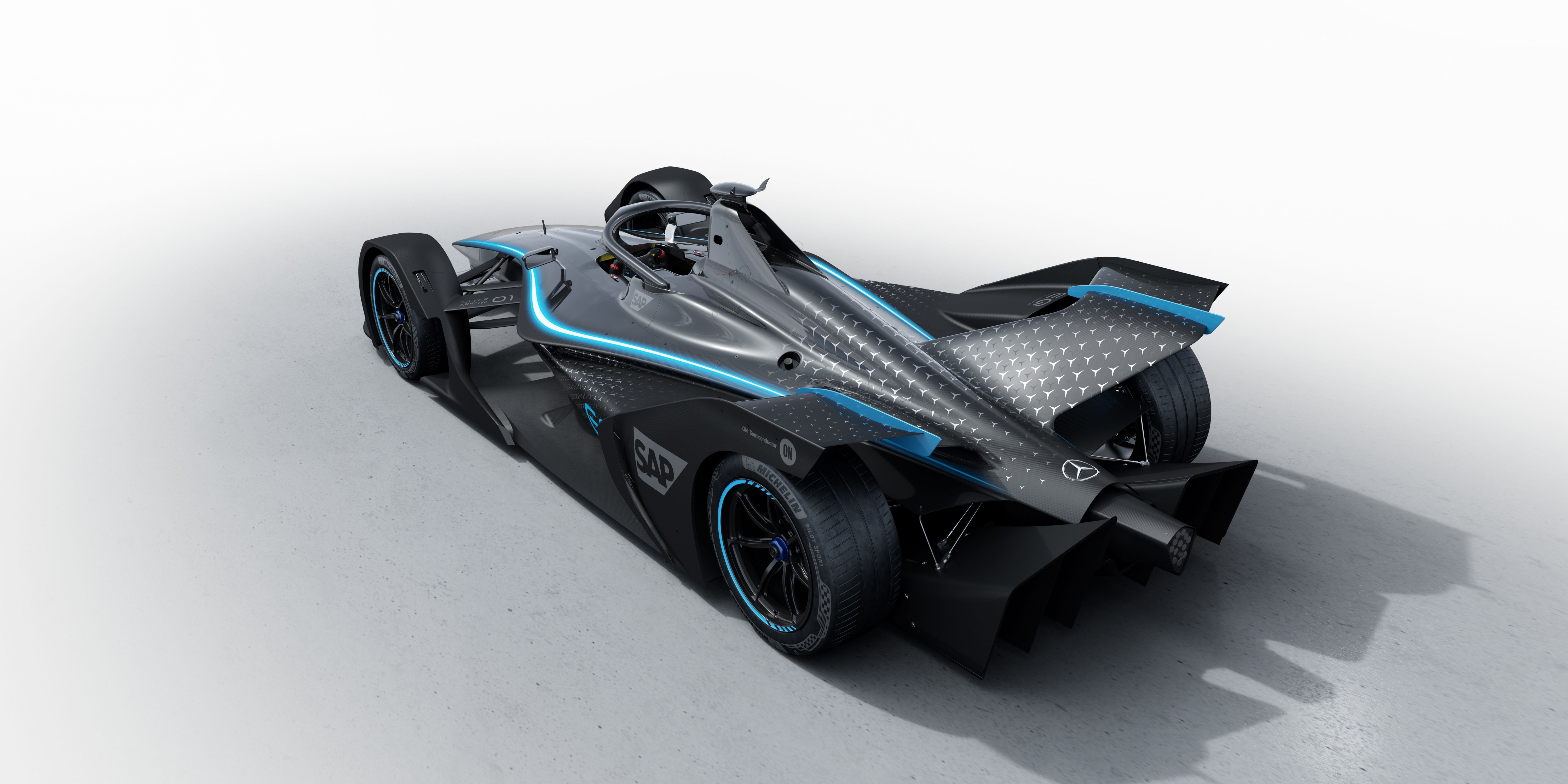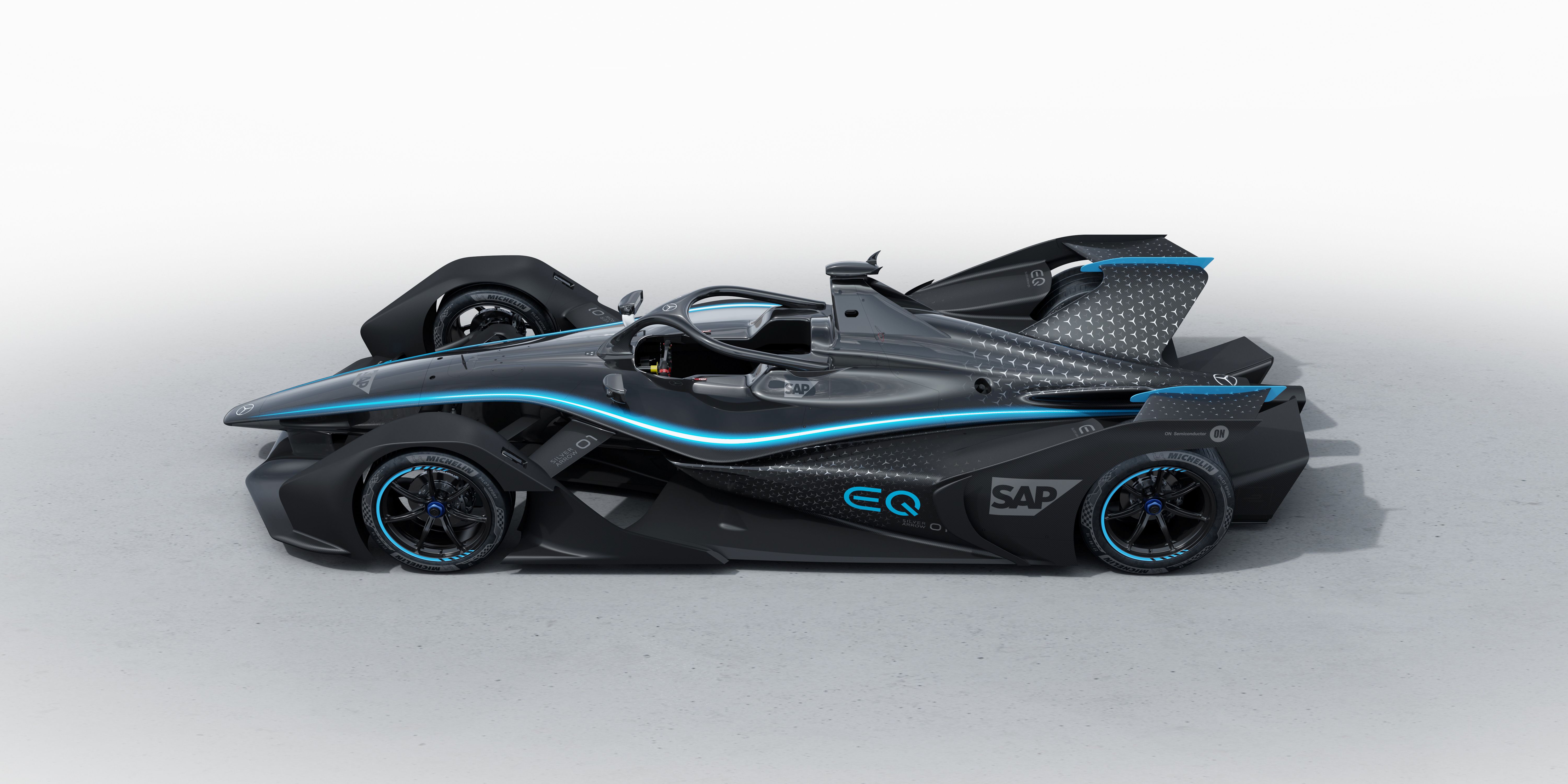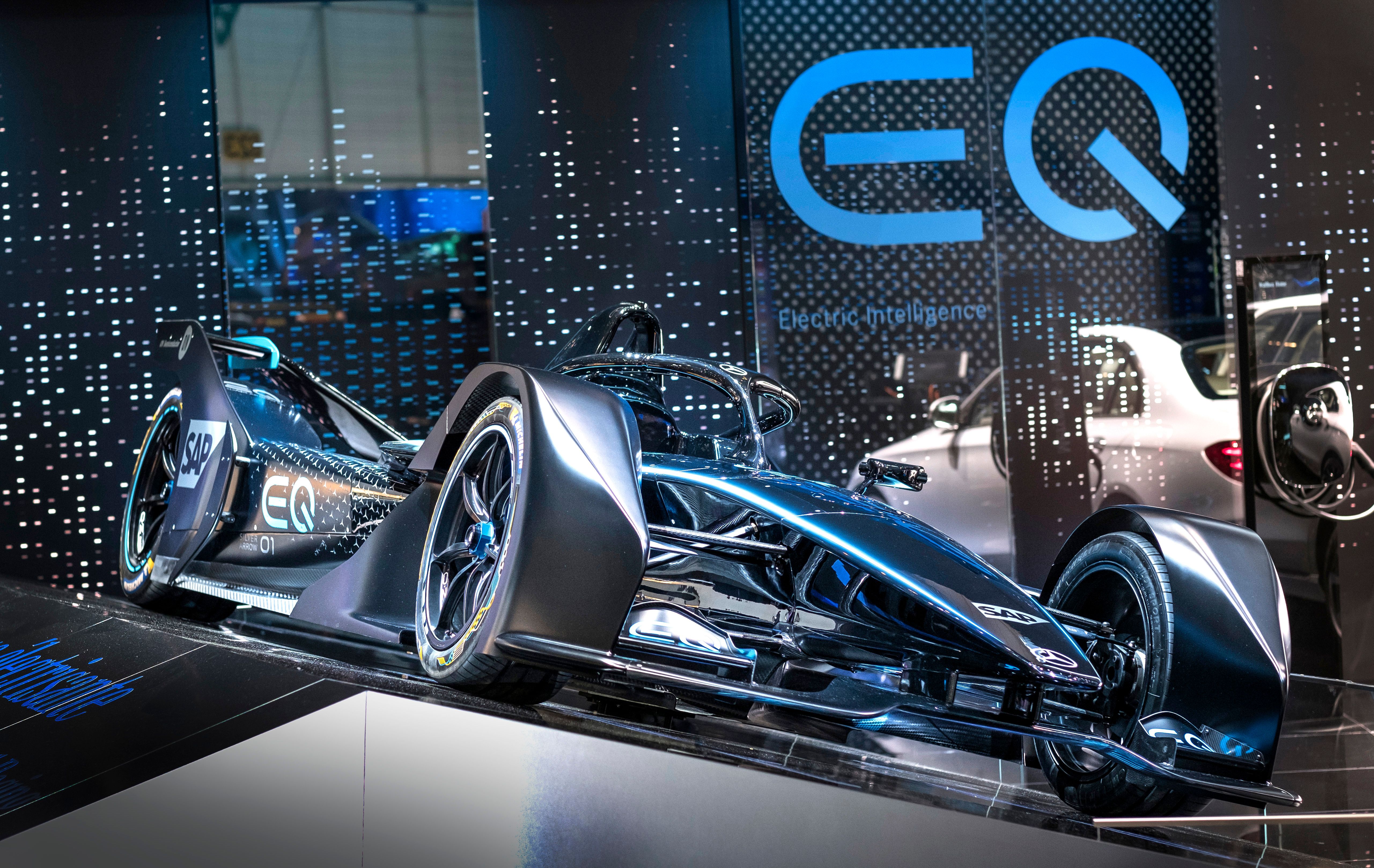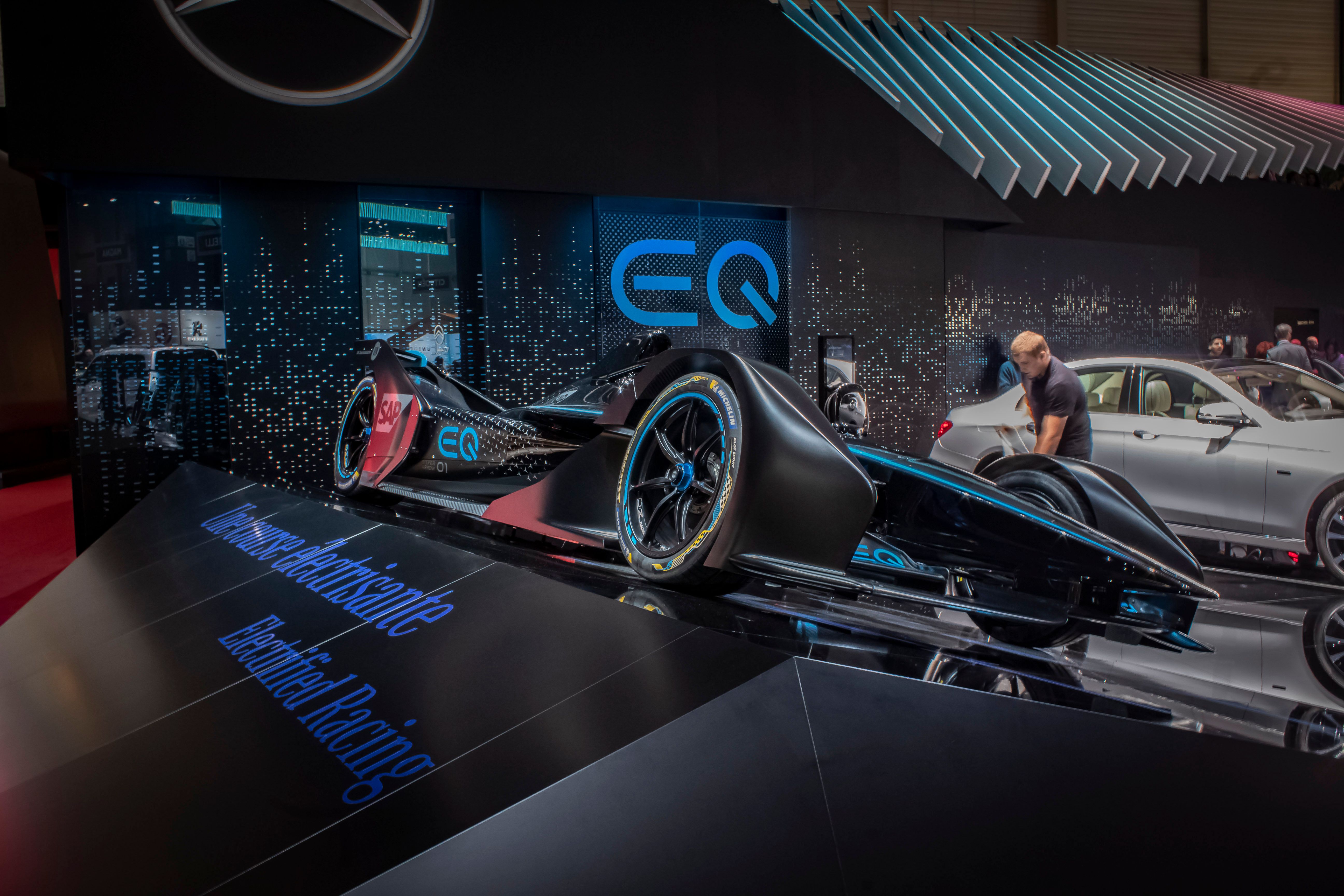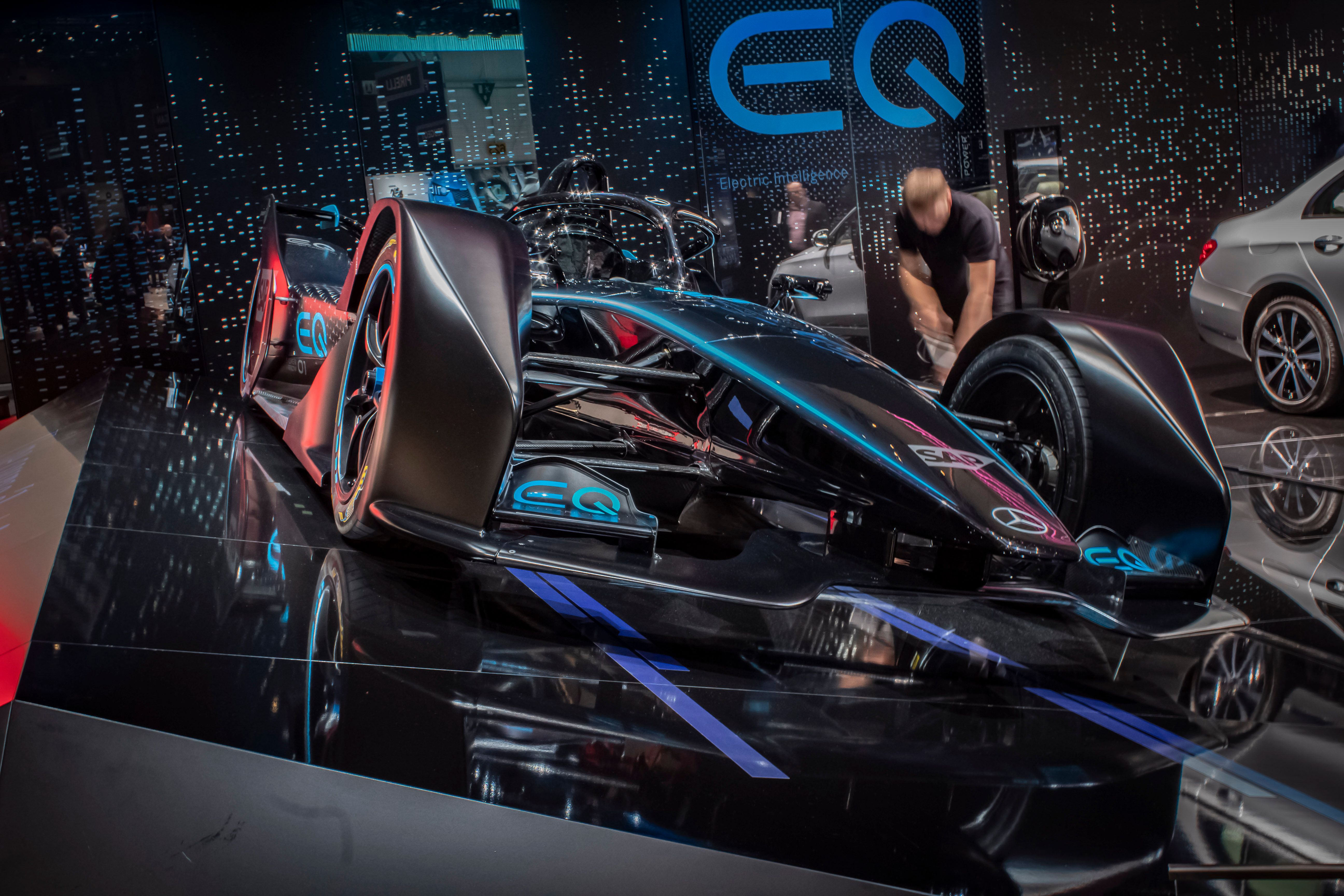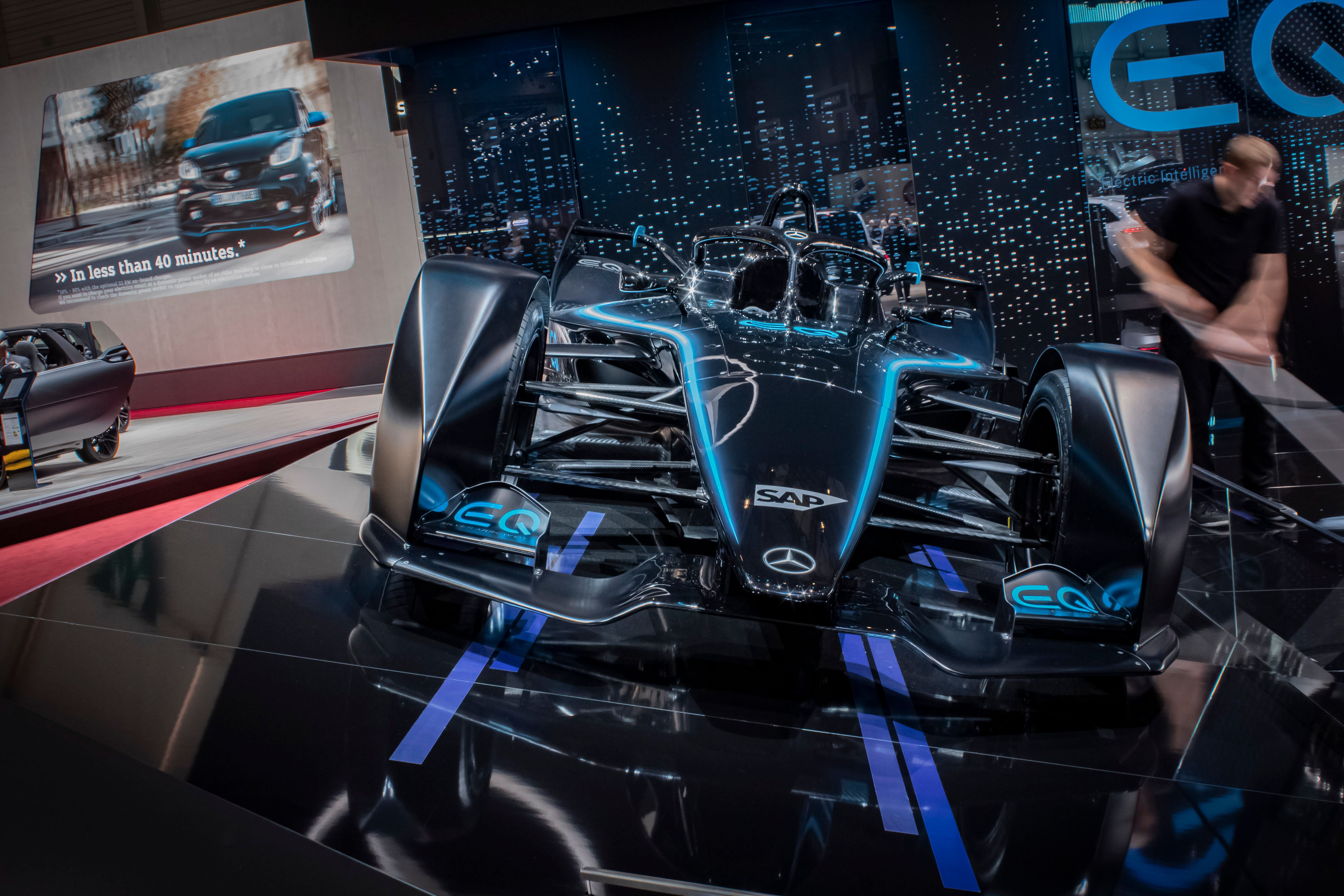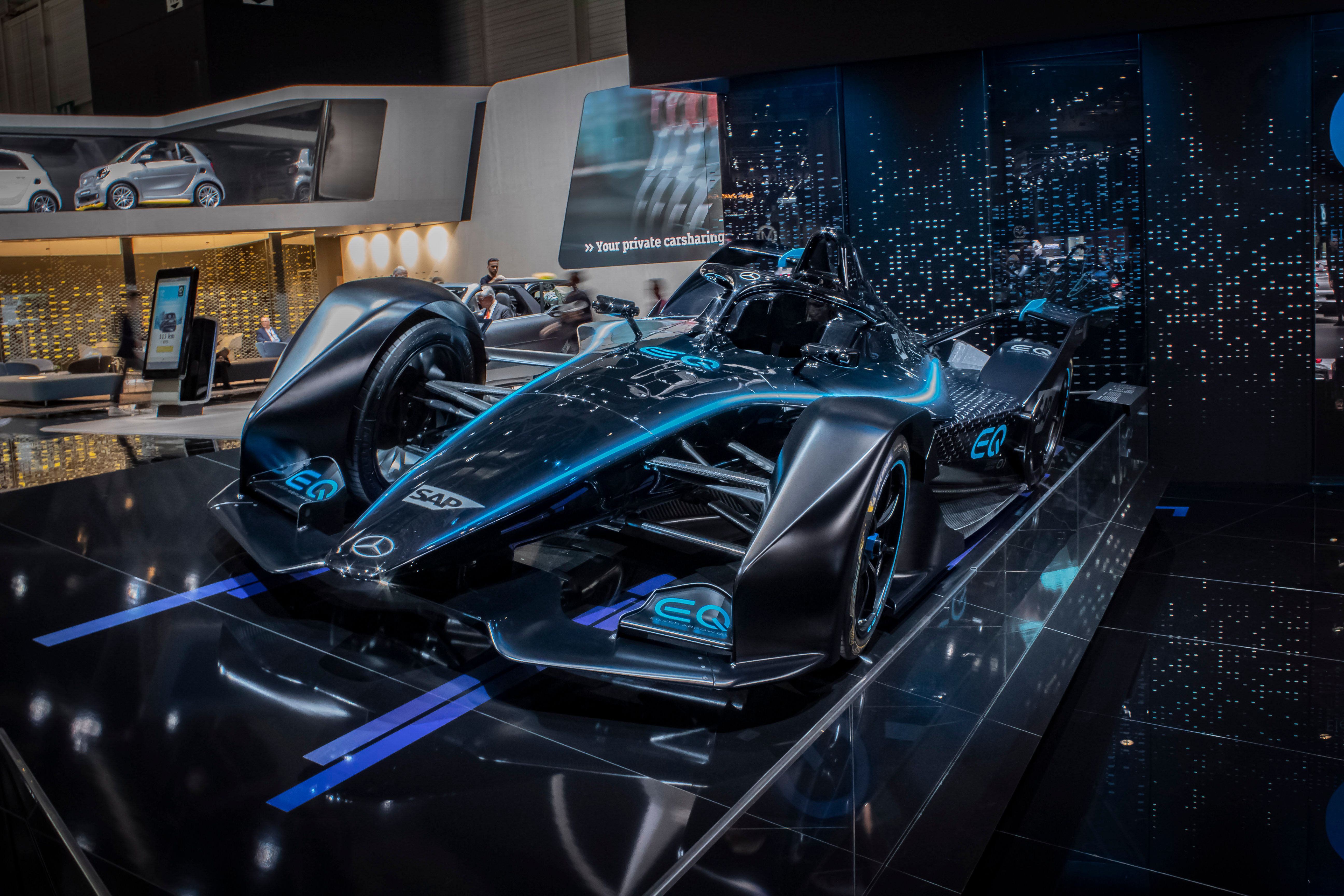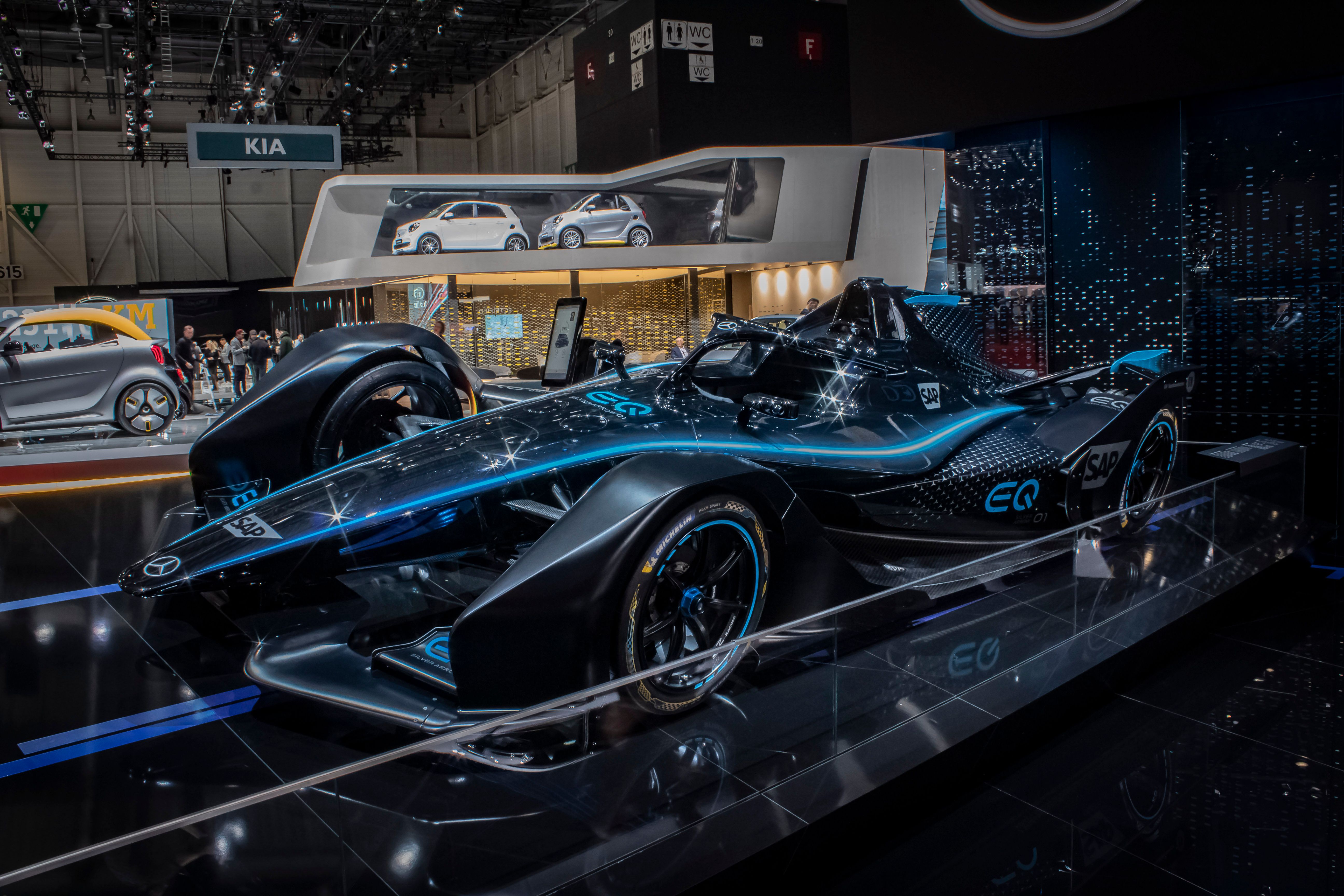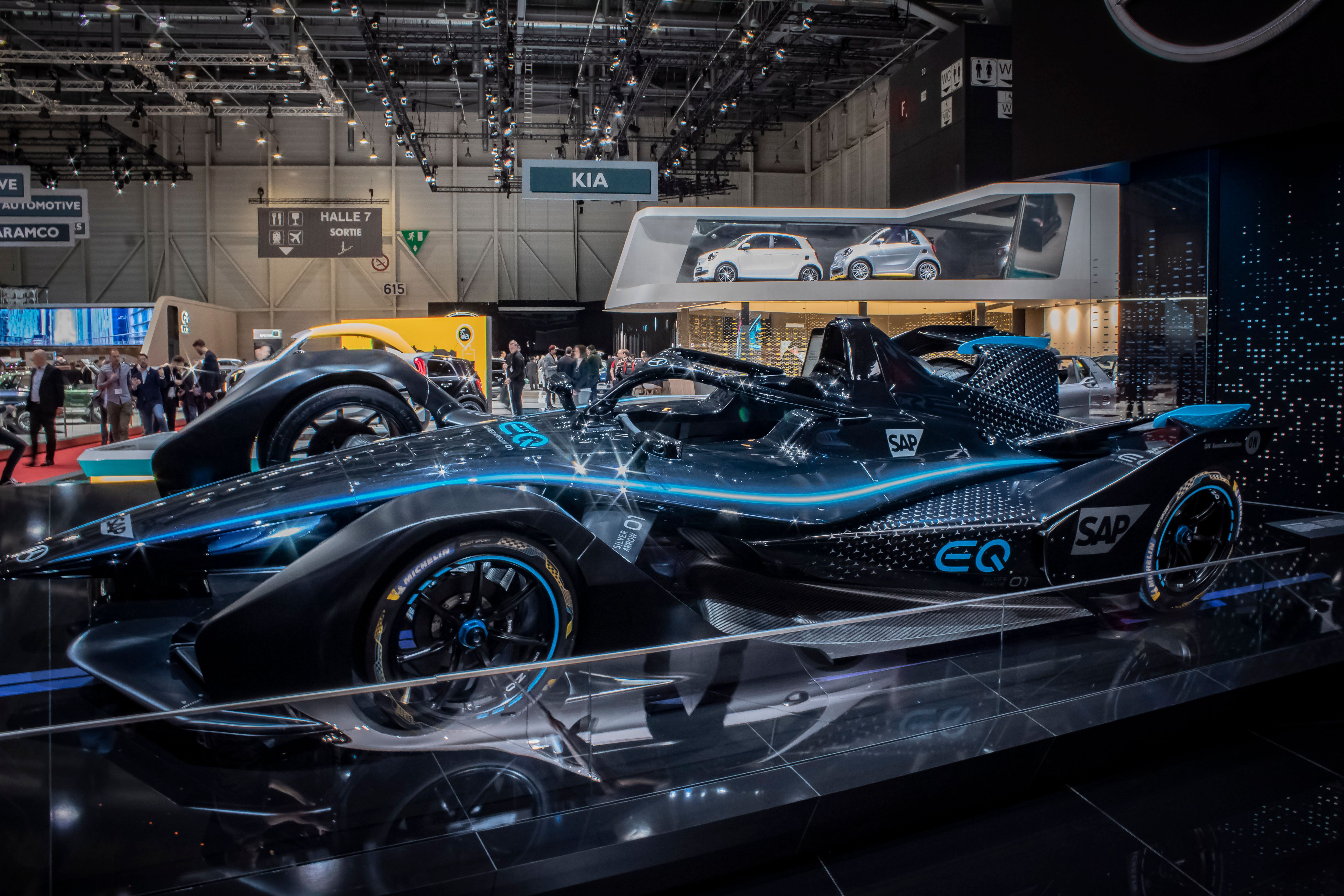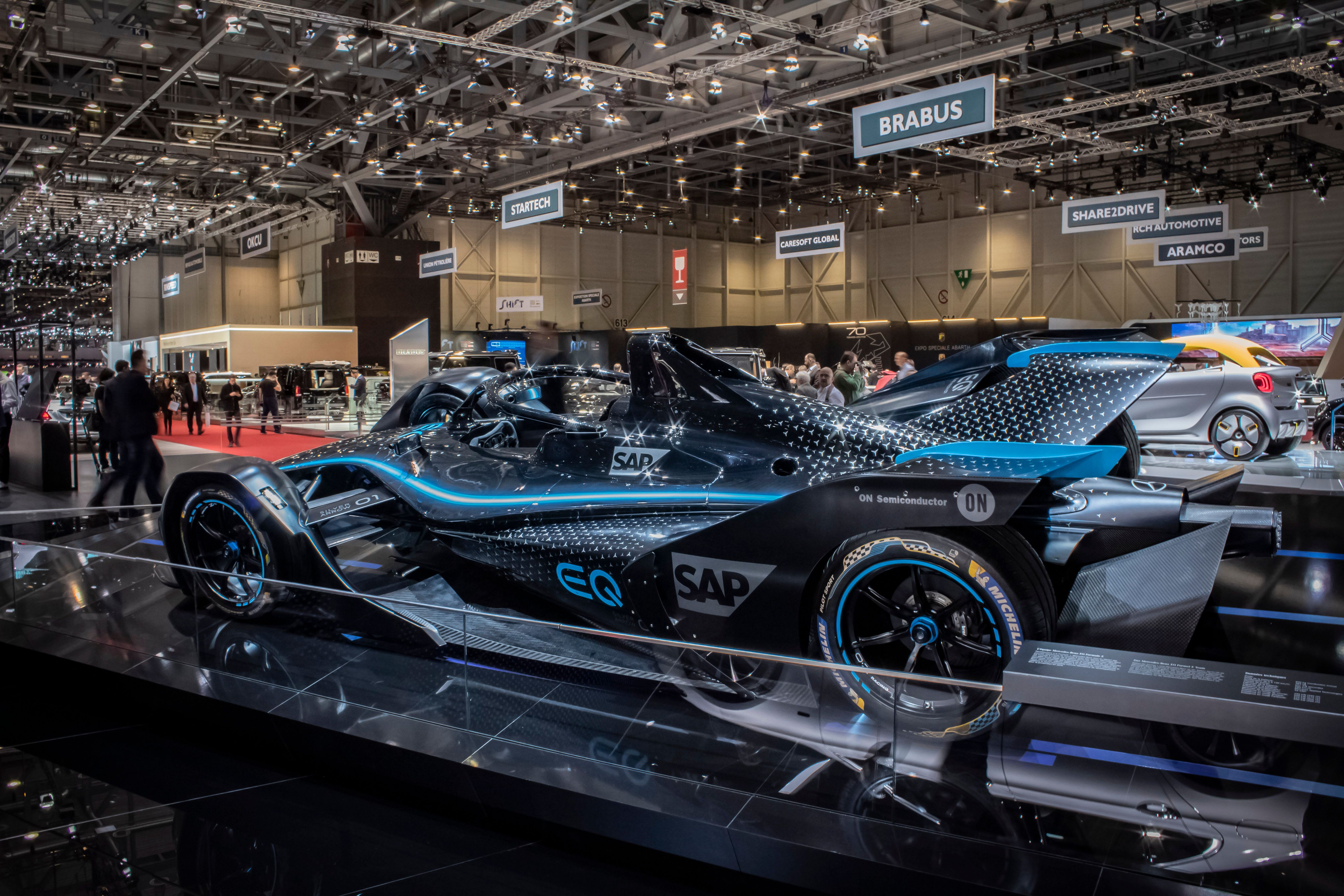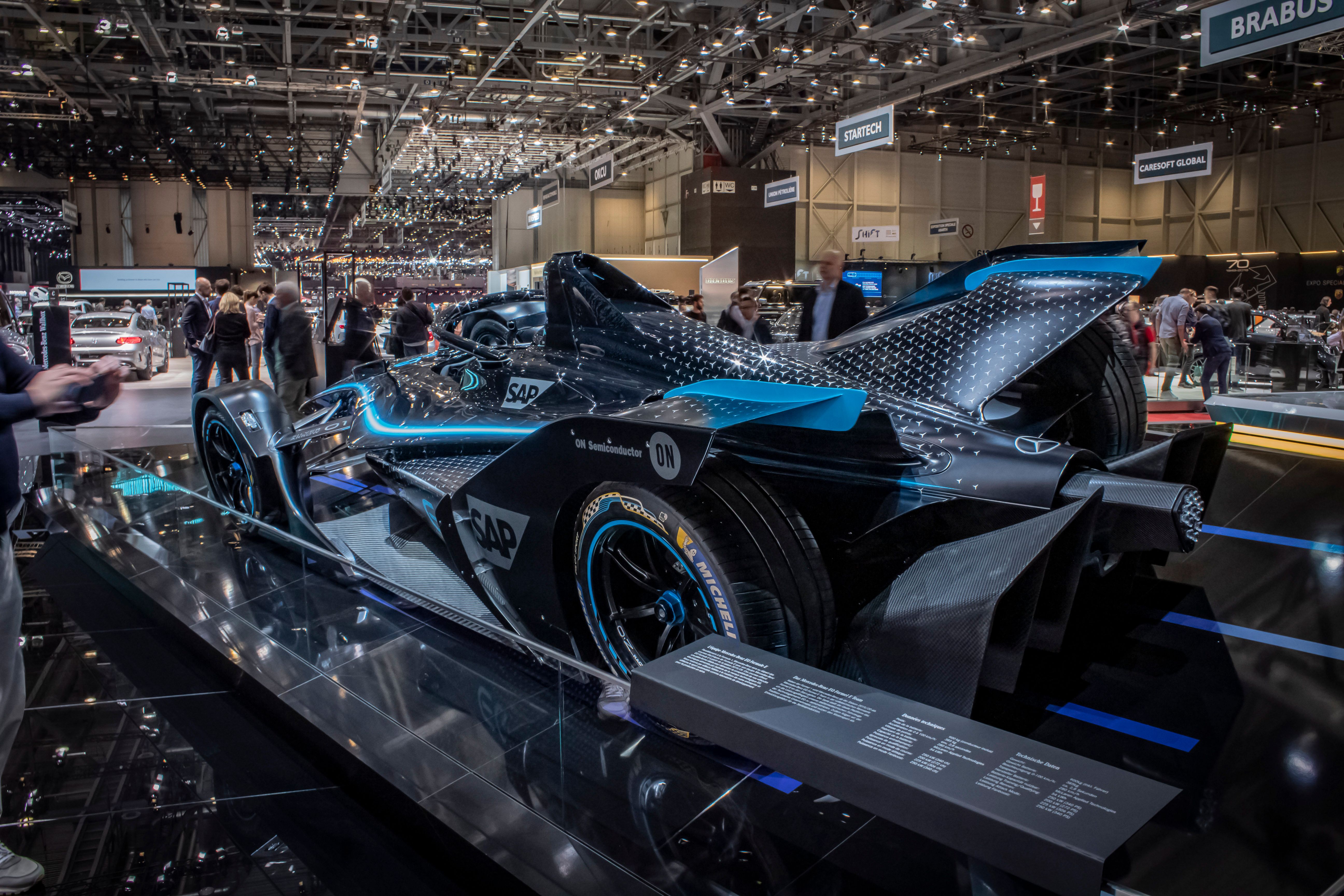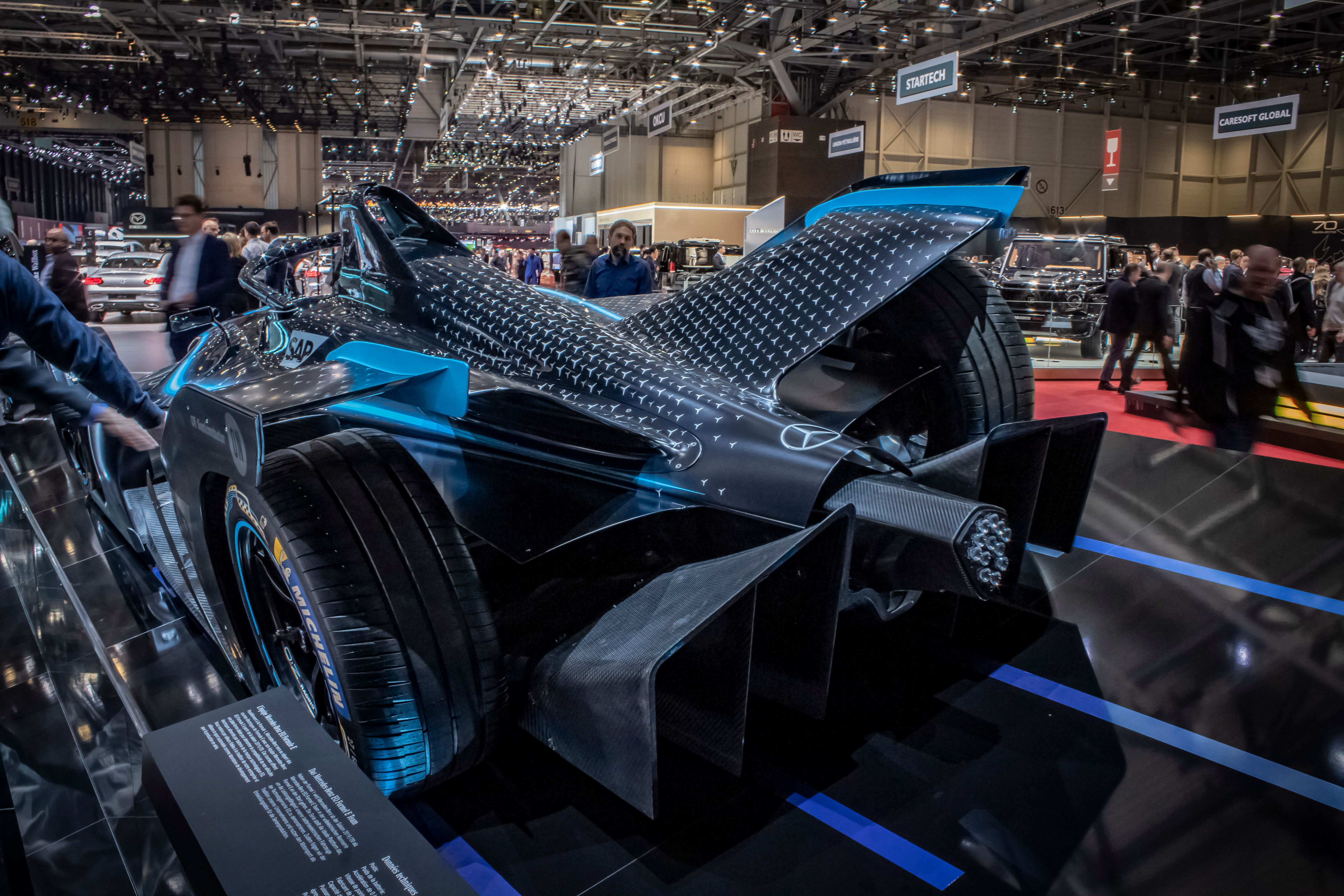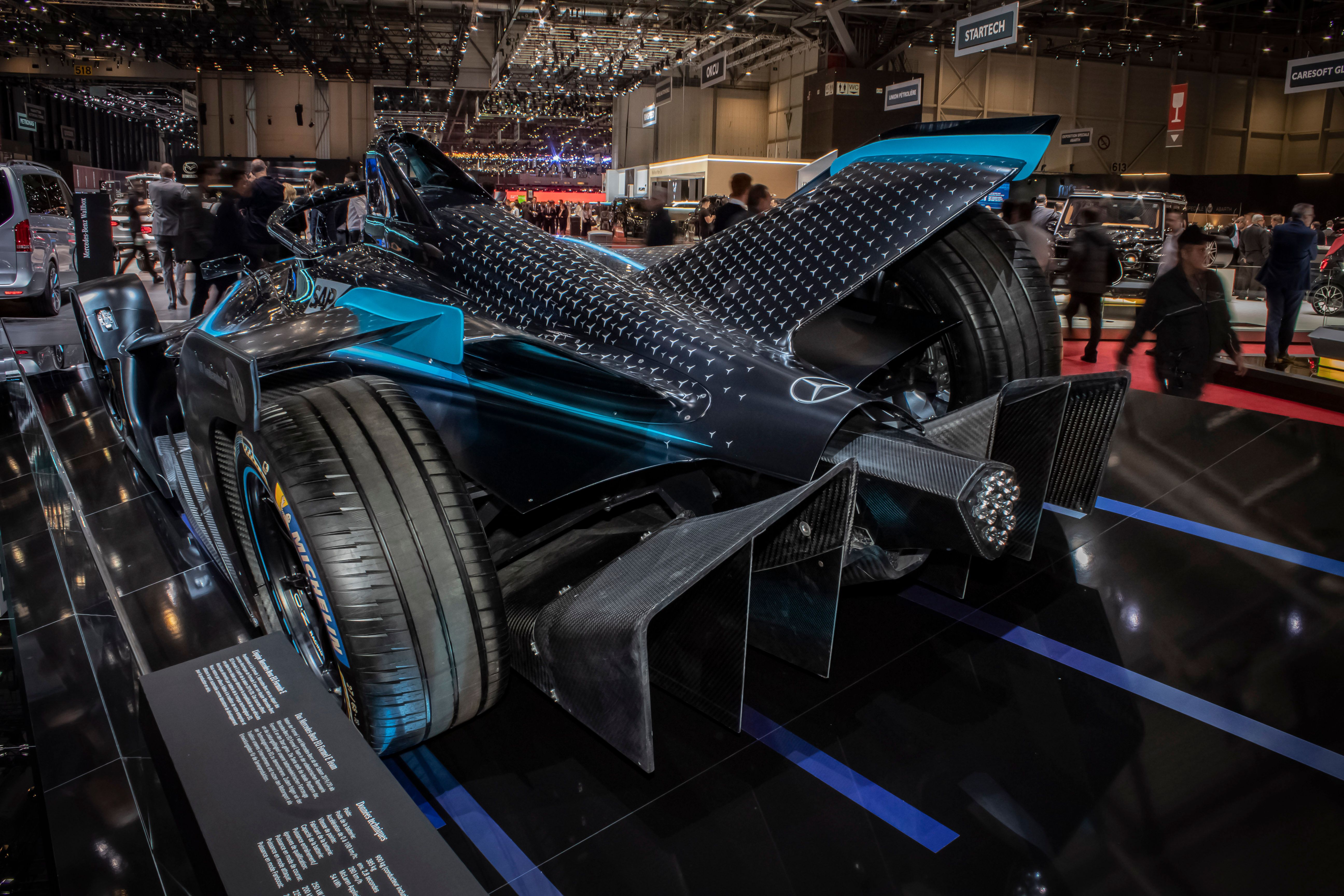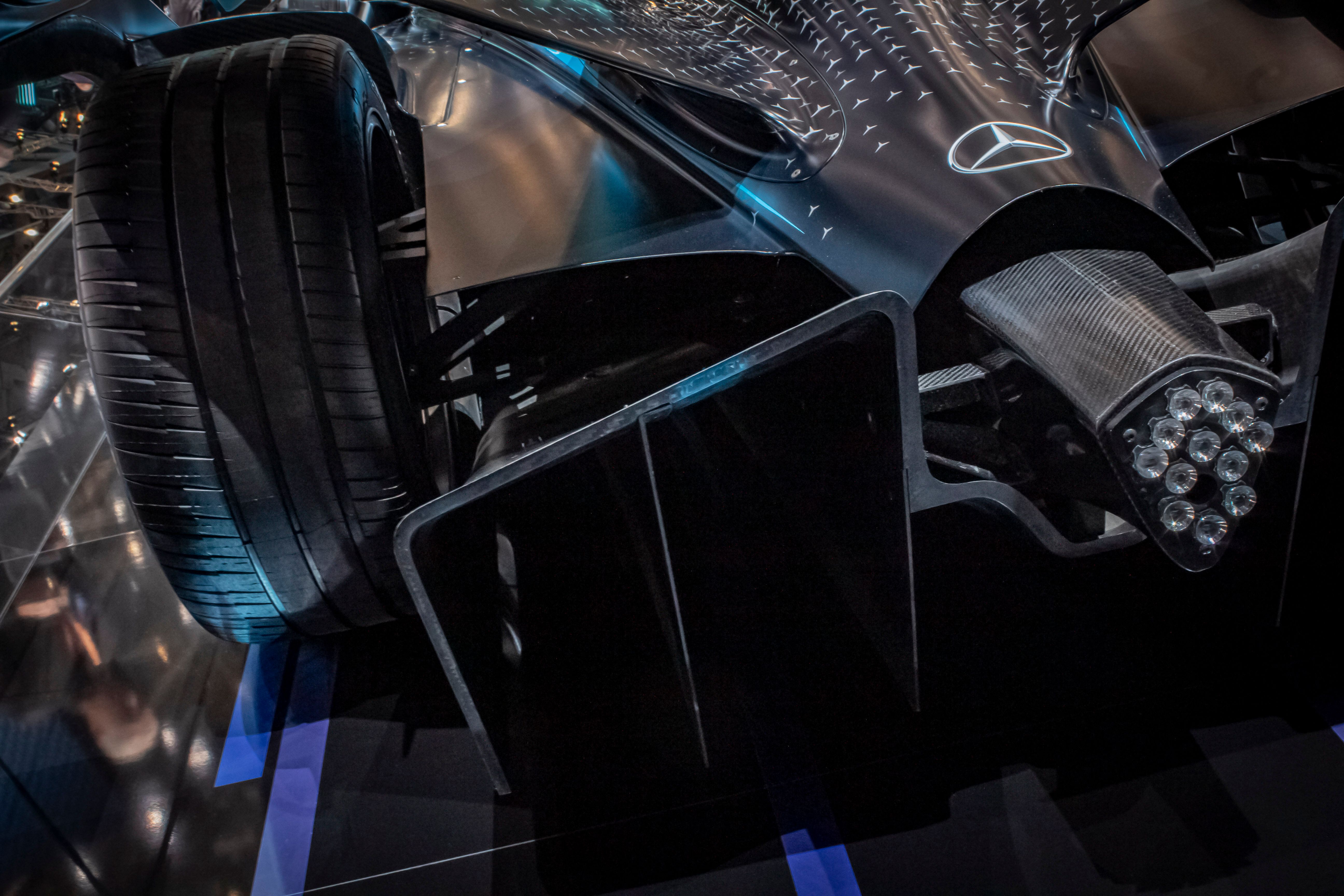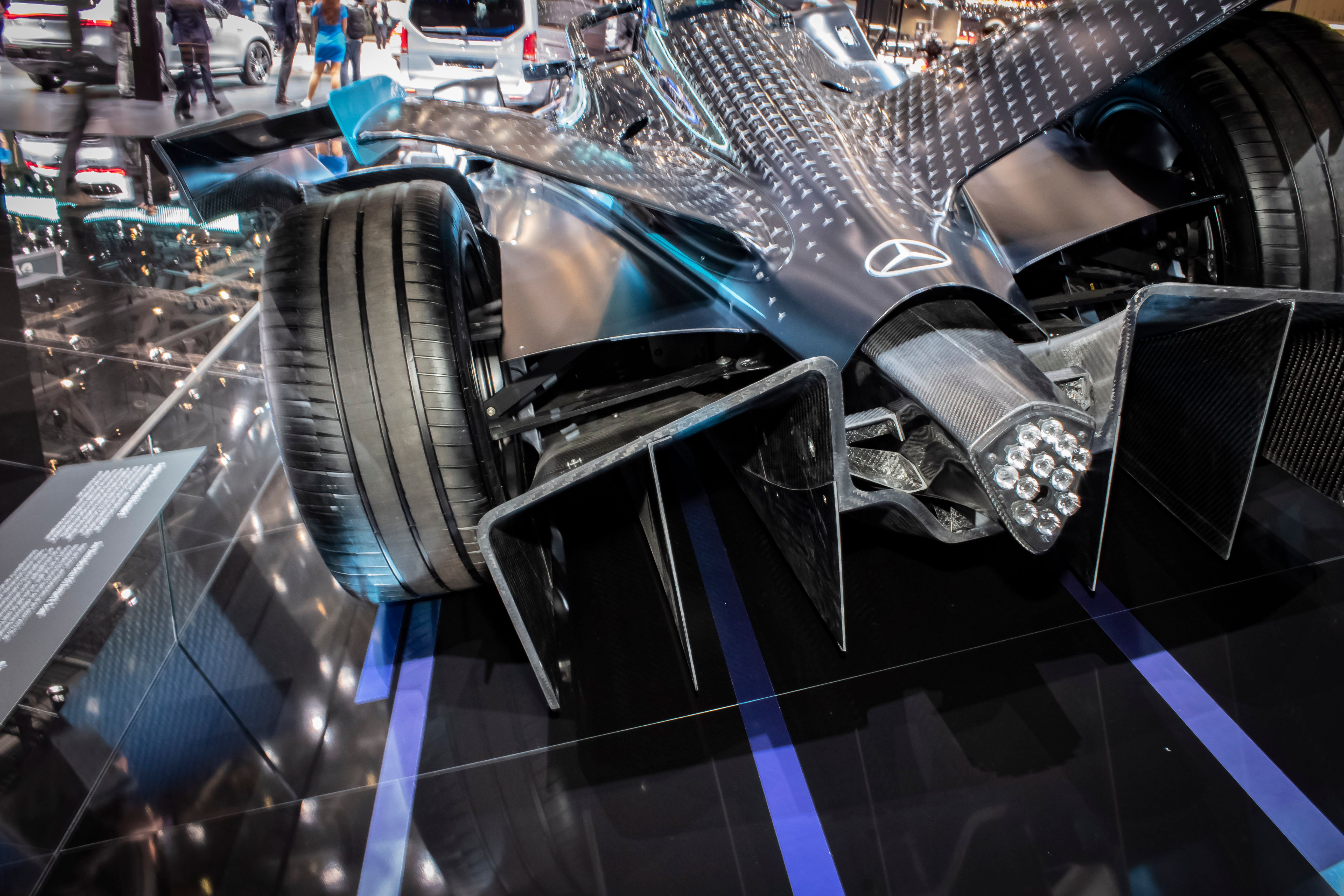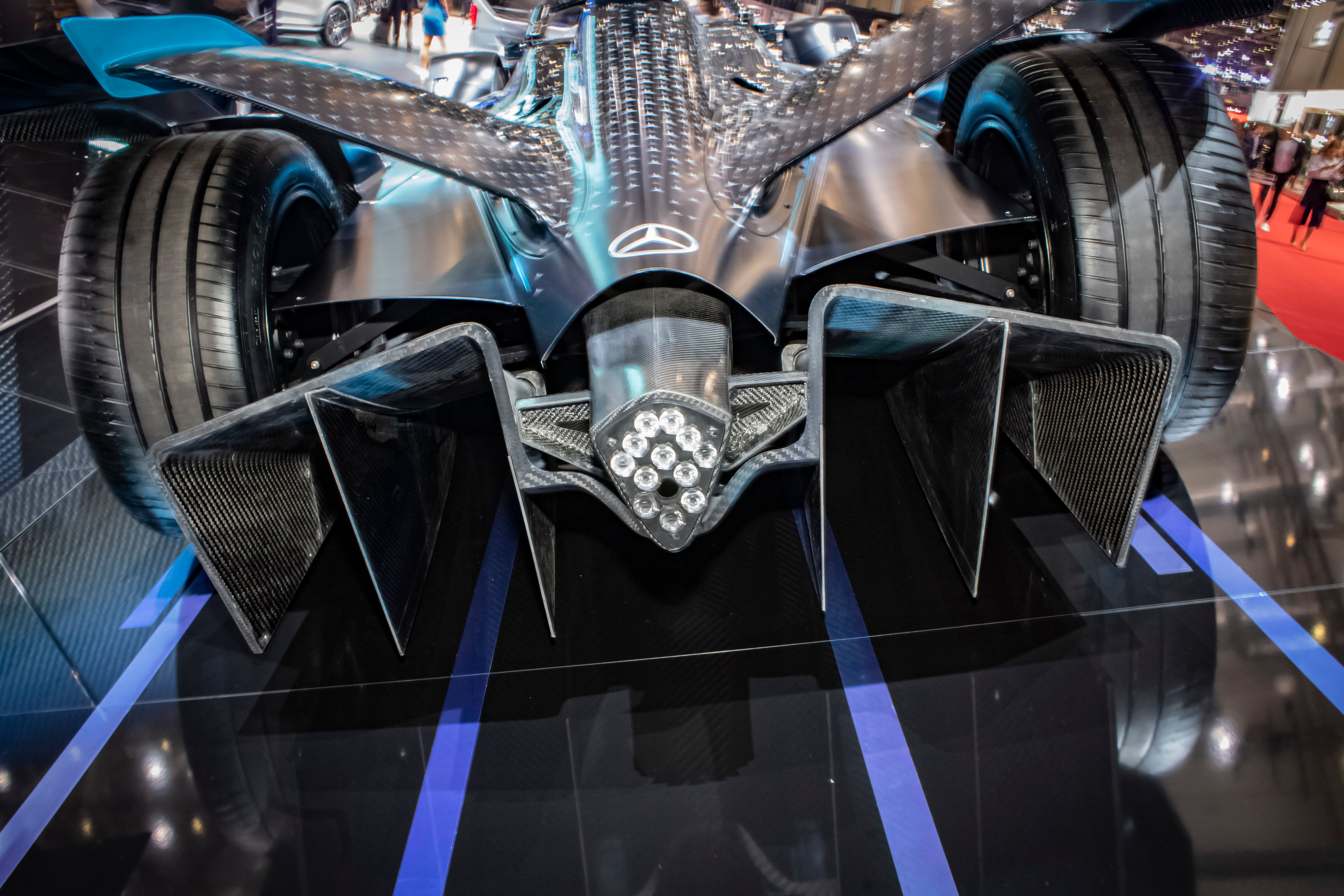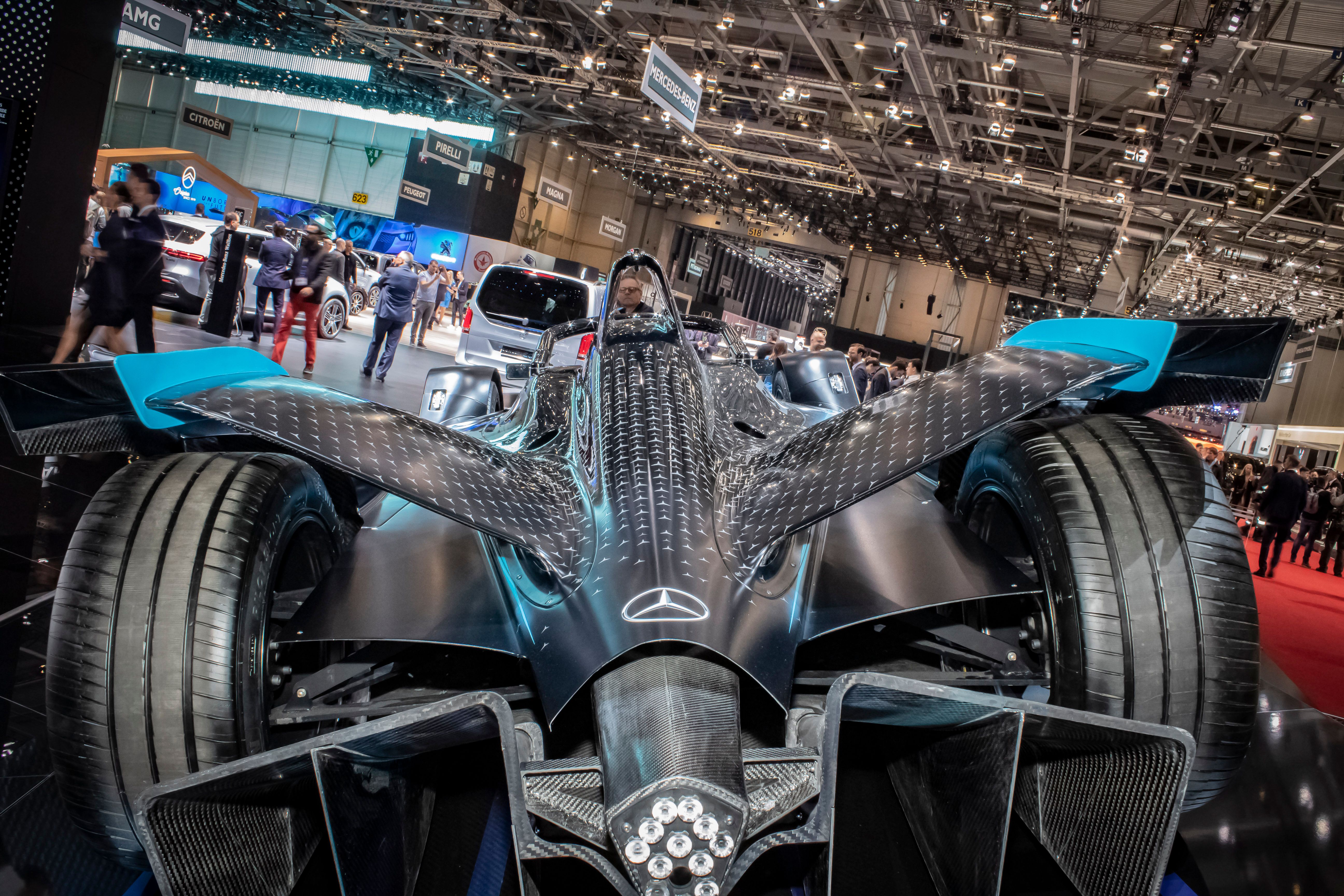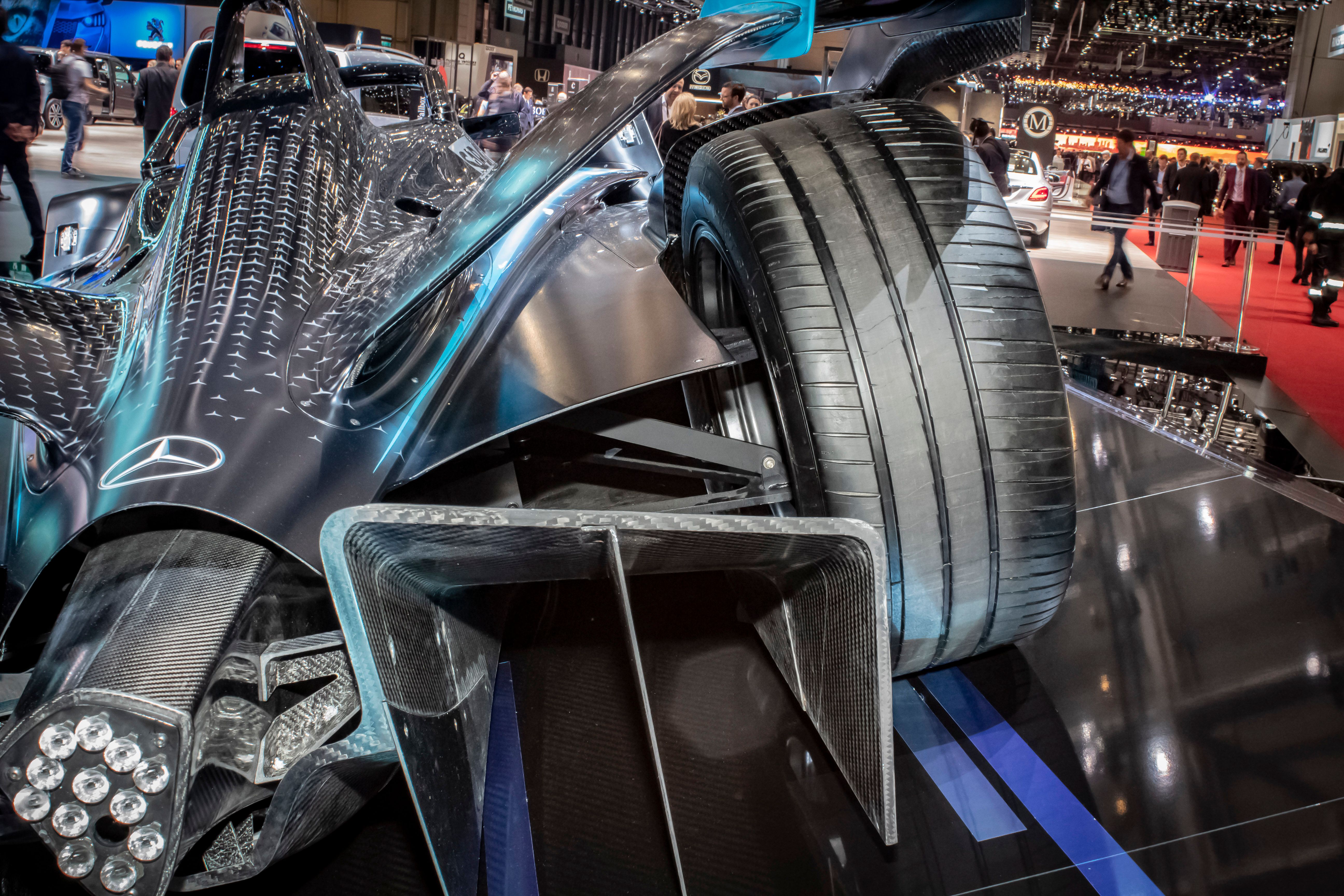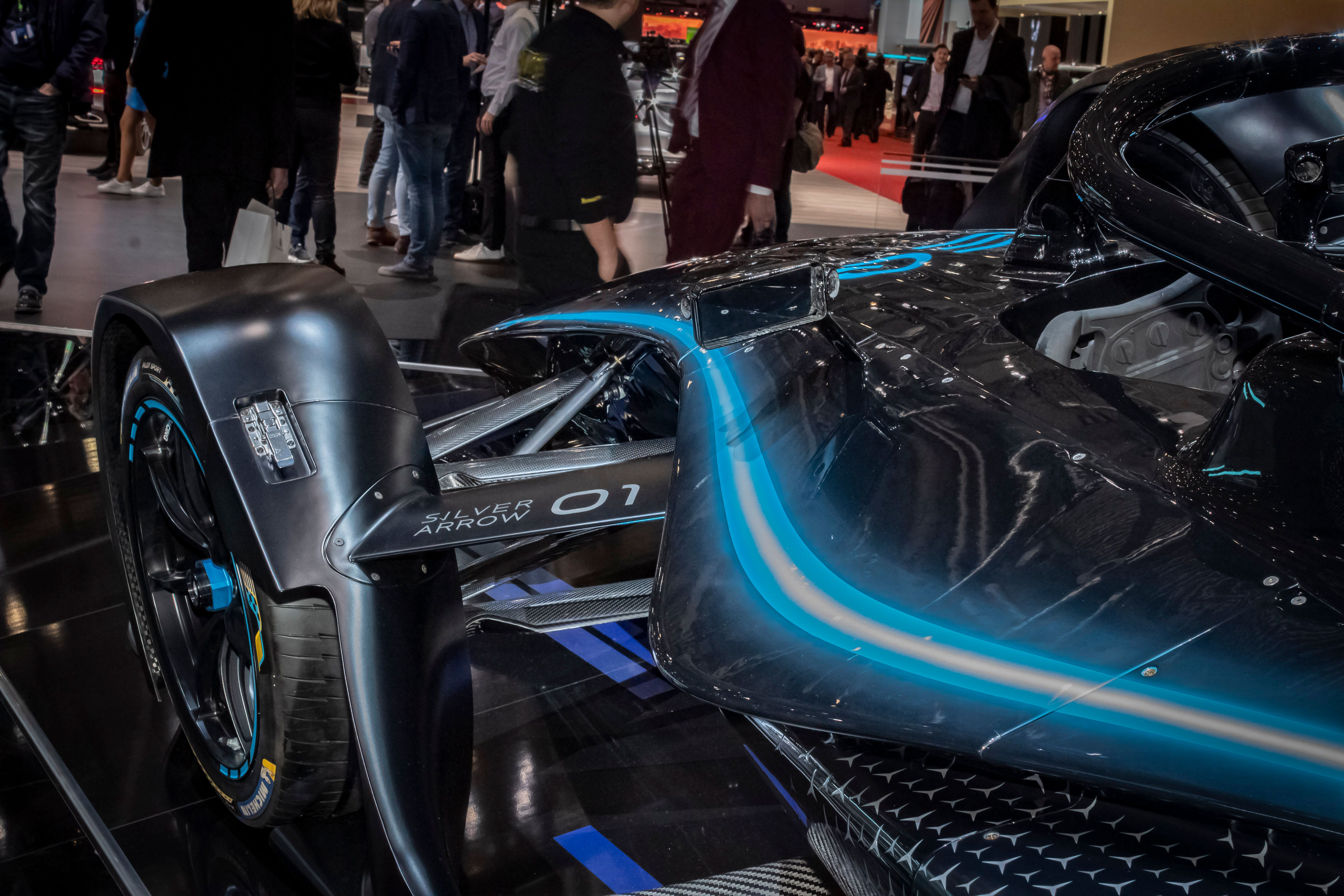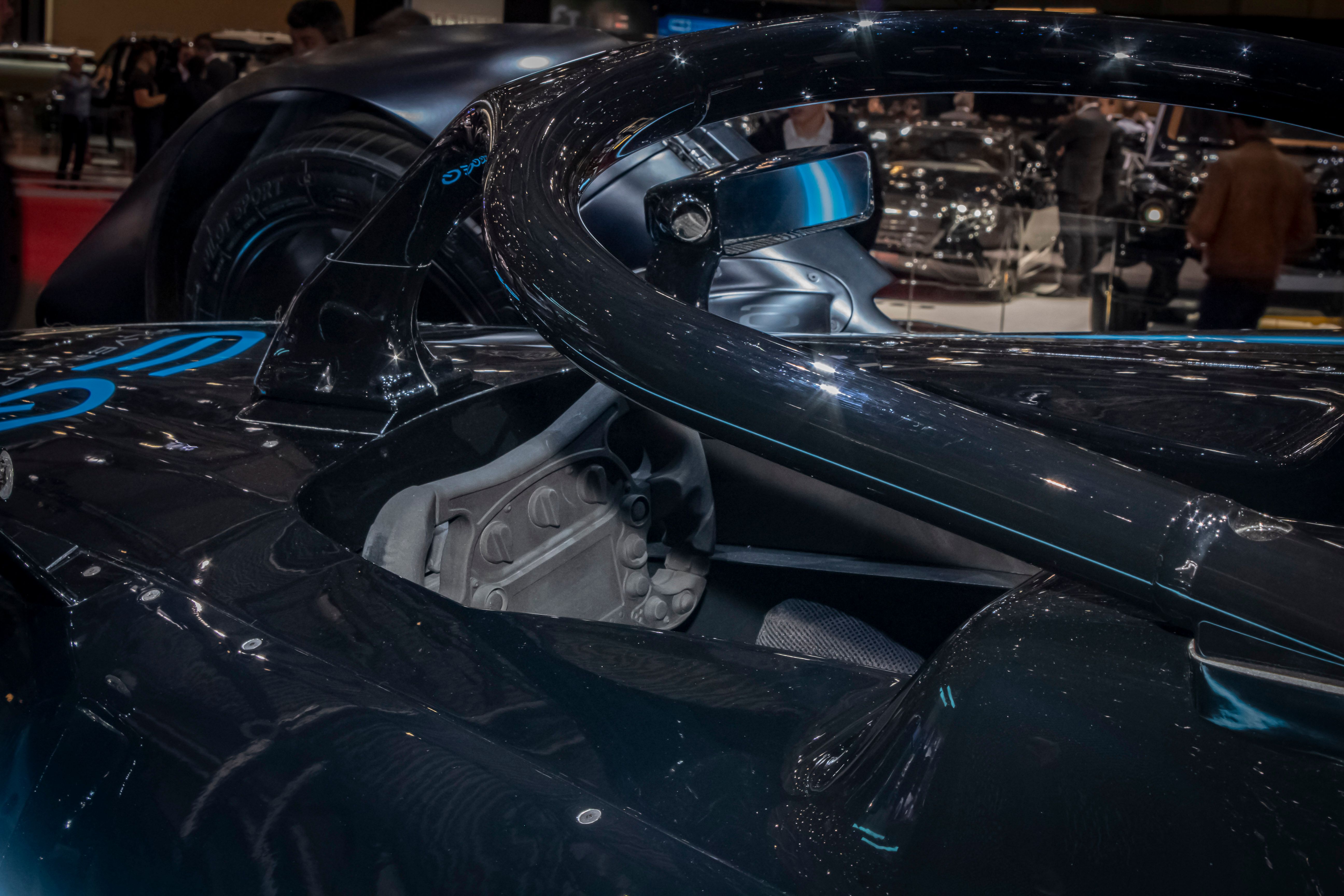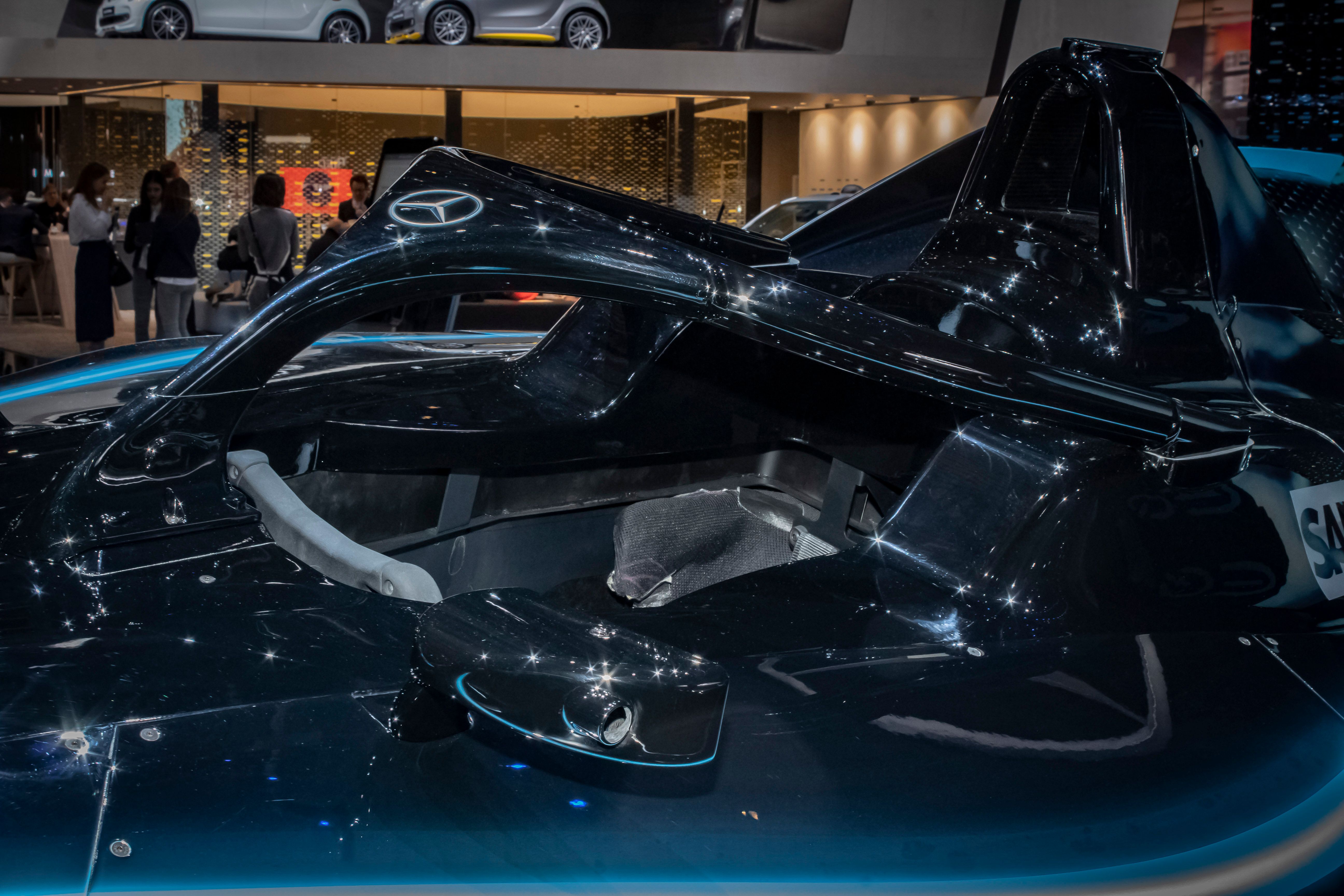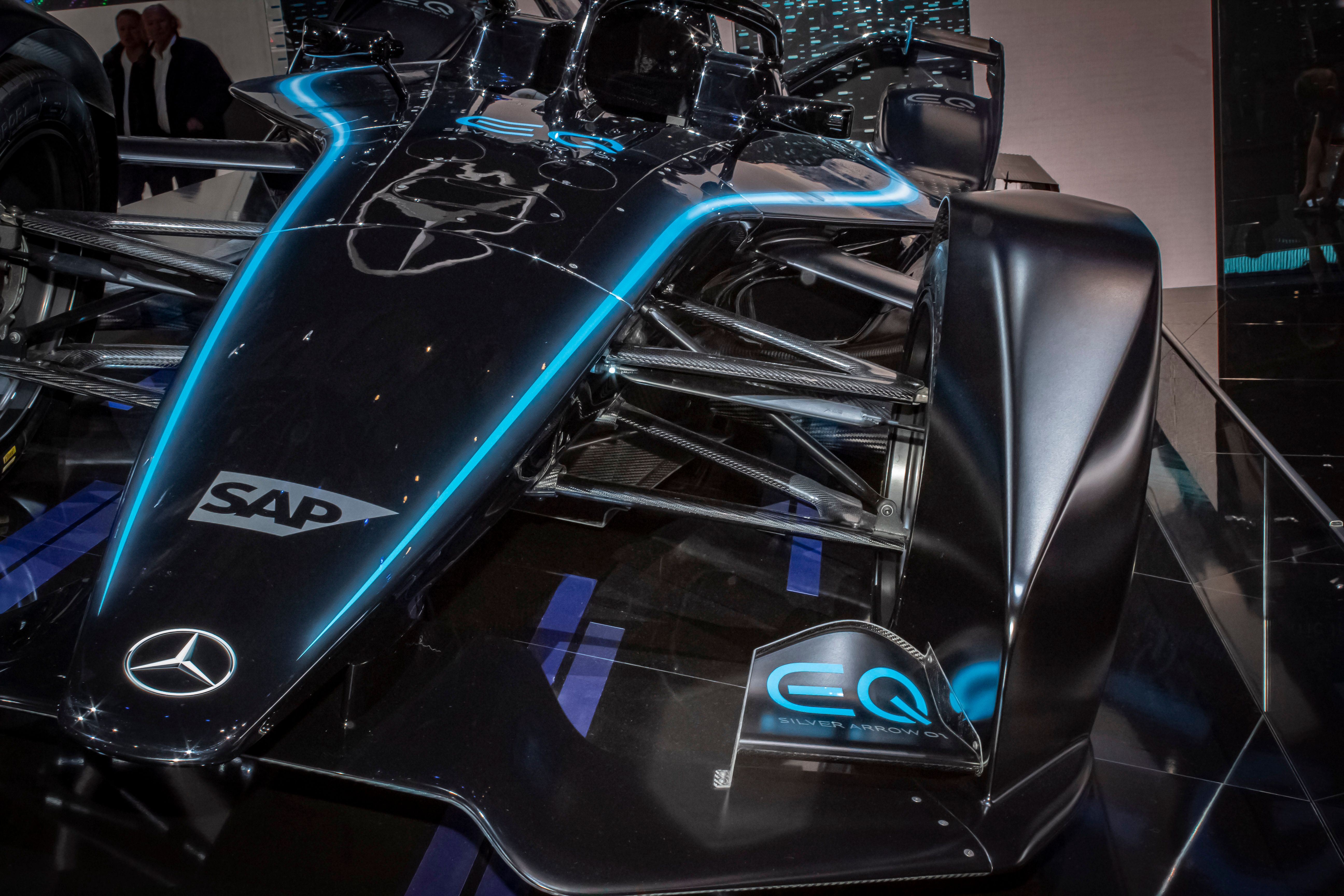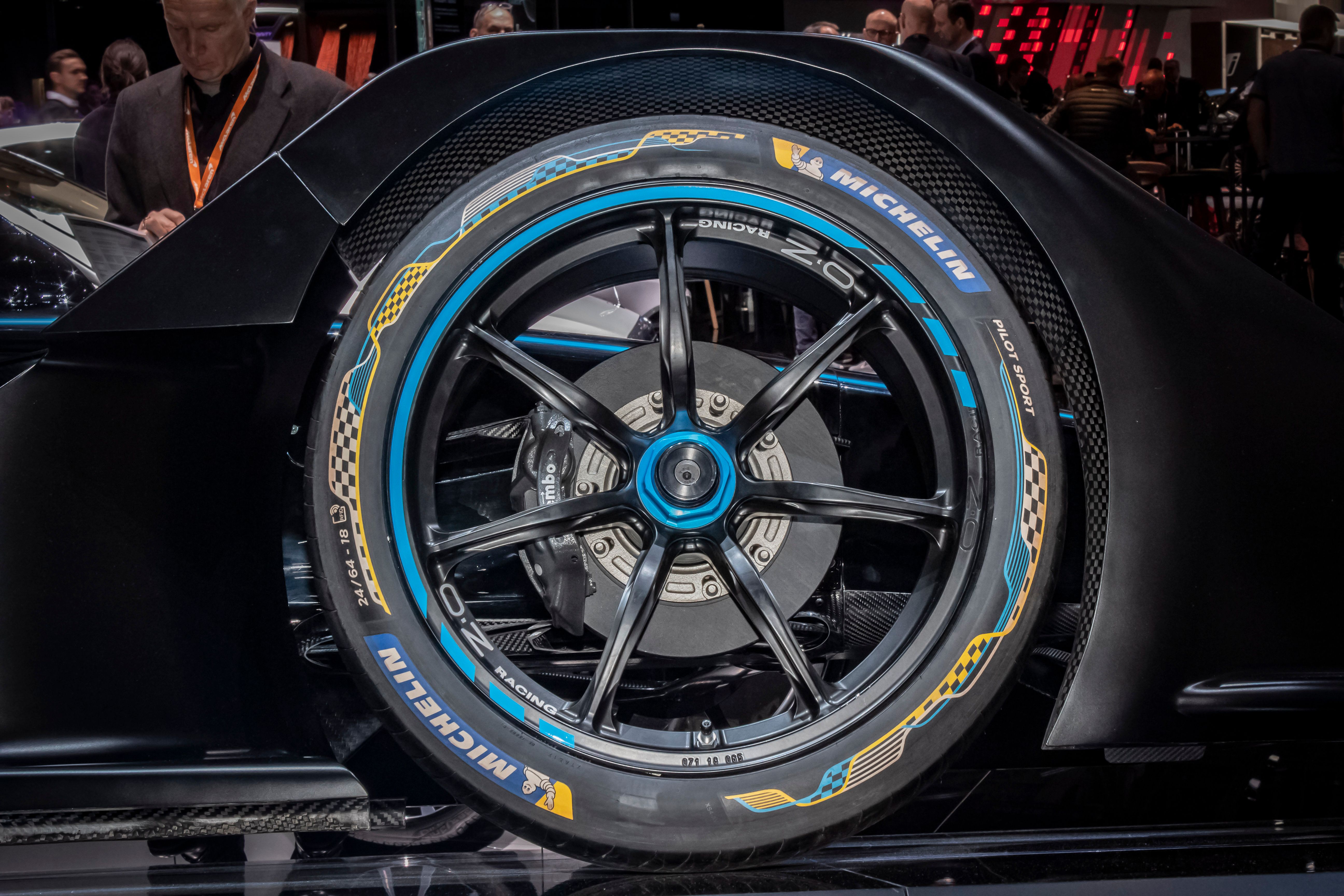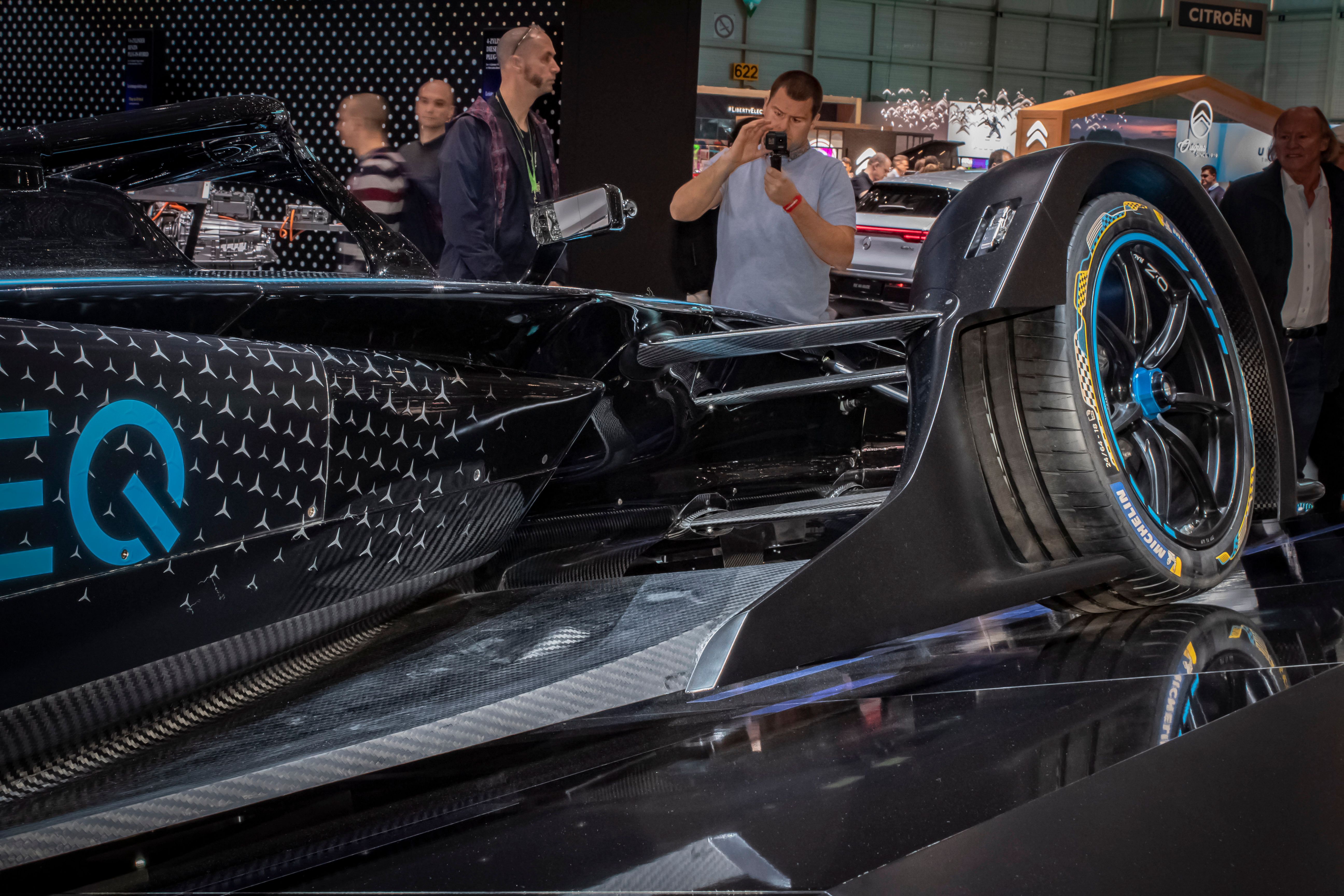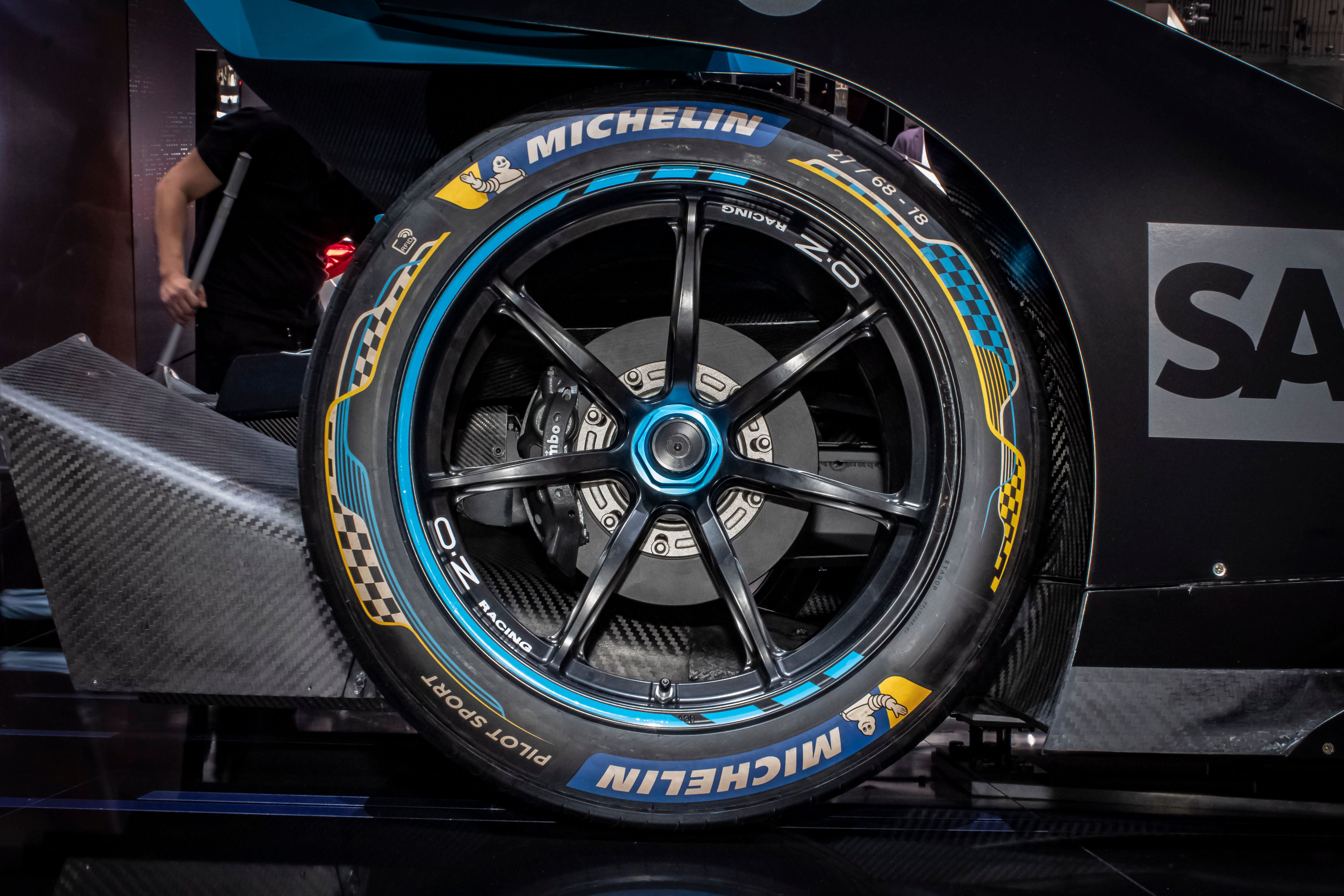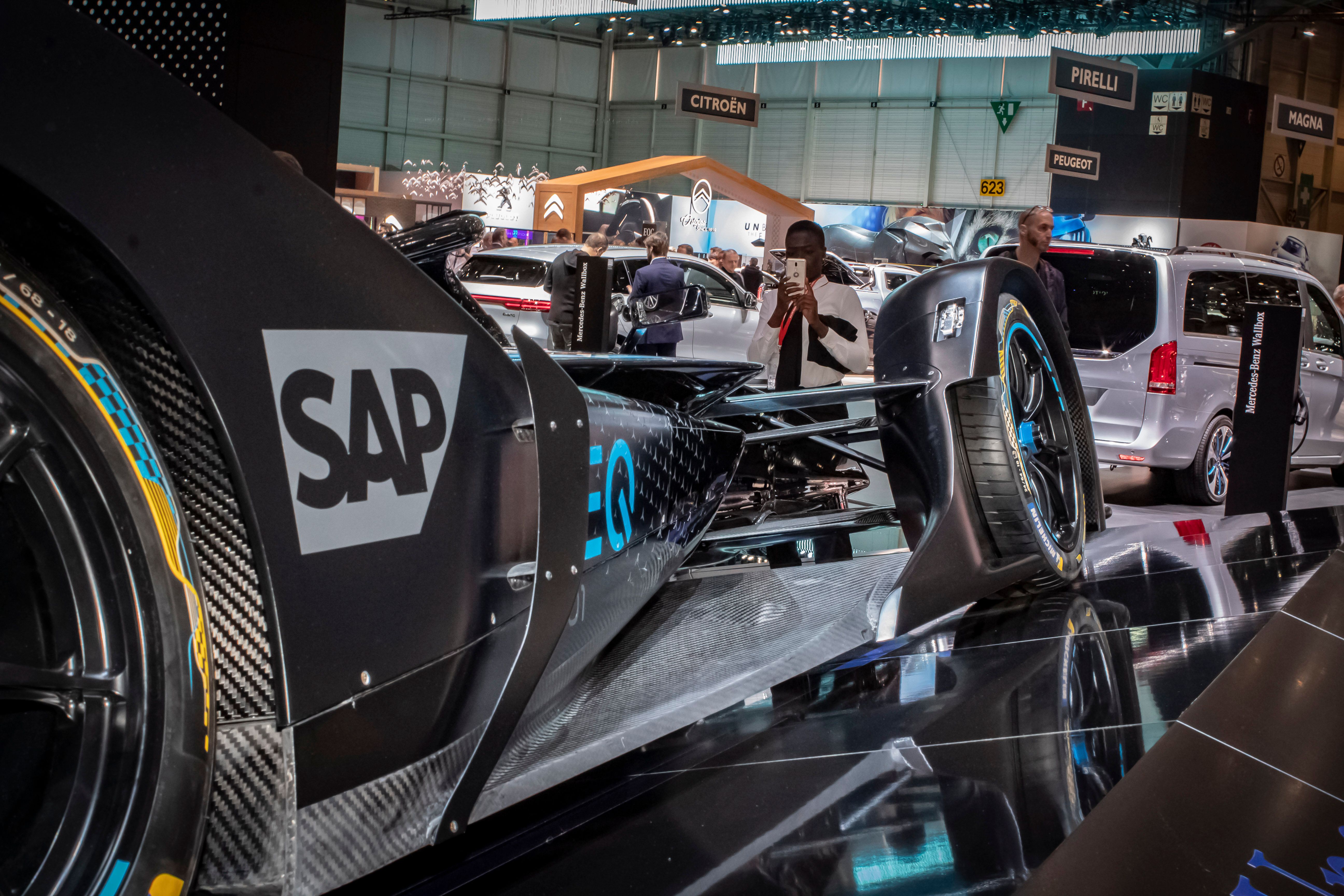After years of speculation, Mercedes-Benz has finally revealed its Formula E contender. Well, sort of. The German manufacturer presented in the eve of the 89th Geneva Auto Show the EQ Silver Arrow 01 wearing a 'concept livery' that is, as you can see, lacking an important element: silver. Rest assured, though, the final livery that "will be presented at a later stage ahead of the season opener" will undoubtedly feature some silver.
Here's an odd one: Mercedes taking the wraps off its first electric silver arrow racer that ominously lacks any trace of silver. That's like Ferrari debuting next year with a blue car in Formula 1. What's more important, though, than an interim livery is what Mercedes is conveying by officializing this move. The automaker from Stuttgart left, to the dismay of many, the DTM at the end of the 2018 season after a 30-year-long involvement in the series to focus on showcasing its electric prowess on track in the world's top arena: the Formula E. The works Merc team will debut next season, which will be the sixth in the history of the championship, and the program will be run by HWA who ran the DTM cars in the last few years and, intriguingly, will operate the new Aston Martin DTM cars this season as well from behind the scenes.
Update 04/03/109: Mercedes has taken the Mercedes-Benz EQ Silver Arrow Formula E racer to the track to perform some in-depth testing. Check out everything we know in our special testing section below!
2019 Mercedes-Benz EQ Silver Arrow 01
- Make: Array
- Model: 2019 Mercedes-Benz EQ Silver Arrow 01
- [do not use] Vehicle Model: Array
Testing
April 3, 2019 - The 2019 Mercedes-Benz EQ Racer Doing Some On-Track Testing
Mercedes decided to unleash its future Formula E EQ racer for some in-depth testing. Since we’ve already seen the car in the metal, there’s nothing to talk about in terms of design changes, but, According to Mercedes, the EQ racer managed to cover some 527 km (about 327 miles) over the last week. Apparently, Mercedes and its Formula E team set out to pull as much data as possible from the testing sessions in regards to the power unit and drive assembly. 300+ miles should have certainly given them a decent amount of data to go through, don’t you think? Toto Wolff, the Head of Mercedes-Benz Motorsport said, “When a new racing car comes to life for the first time and goes out onto the track, that’s always a very special moment. Not only have we reached an important milestone for our as yet young team, but we have also laid a solid foundation for further development. But there is still a lot of work to do before our race debut when the next season starts towards the end of this year.”
It'll still be a while before the Silver Arrow 01 officially makes its race debut, but there’s no doubt in our minds that MB will be more ready than ever.
Mercedes-Benz EQ Silver Arrow 01 Exterior
The body of Mercedes' official Formula E challenger is menacing but this is just the 'concept livery' used for the launch of the program. The final livery will be different.
Audi's contender for season number five, that's already underway, combined the green of main sponsor Schaeffler with black and white and some hints of yellow around the nose cone where the DHL logos are displayed in full view of the cameras that feed live images of each and every race meeting. The Audi E-Tron FE05 is as important a car for Audi as is the EQ Silver Arrow 01 for Mercedes-Benz. Audi had been involved in a semi-official quantity since the series' first season that spanned between 2014 and 2015 through the ABT outfit but only entered the championship as a full-blown works team in the season that began in December of last year.
Similarly, Mercedes-Benz is already testing the waters in FE by supporting the HWA Racelab team that runs a pair of Spark-built Venturis for Belgium's Stoffel Vandoorne that's been recently sacked by McLaren and ex-DTM star Gary Paffett. Both had a particularly tough start to their campaigns, each marred by a couple of retirements and a couple of lackluster finishes in the second half of the field. It's clear that HWA has to step up its game before next year when they'll be running a Mercedes-developed car built by Spark.
By comparison, Audi is fairing a whole lot better: Lucas Di Grassi won the most recent round in Mexico making it four different winners (from four different rounds) in four races. The results in the previous three rounds of the 2018/2019 season were as follow: In Ad Diriyah, Antonio Felix Da Costa won for BMW i Andretti Motorsport, in Marrakesh, Belgium's Jerome d'Ambrosio came first driving for Mahindra Racing, and in Santiago de Chile, Envision Virgin Racing's Sam Bird was on the top of the pile.
As I said, the design itself is nothing new, all Generation 2 Formula E cars look the same: an elongated nose, wings that blend with the fenders and no conventional rear wing in the back but, instead, two wings that start from the sides of the engine cover and extend outwards to meet the heightened rear fenders. Everything looks a lot more elaborate on the Generation 2 cars and this is very much the case as now the cars are a little bit faster, can go a full race on a single charge of the batter - so no more mid-race pit stop to change cars -, and, as such, aerodynamics are more important than before.
In the front, the sloping nose is a nice home for Mercedes' very own three-pointed star.
"Blue accents and the subtle contrast between matt and gloss in conjunction with the star pattern at the rear of the vehicle stage the progressive luxury in electric motorsport,” is how Gorden Wagener, Chief Design Officer of Daimler AG described the choice of livery. These blue accents are present on the lip of the seven-spoke black alloys.
The car's front fenders narrow down towards the front where they are connected with the wing that has an additional horizontal winglet on top connected to the large endplates. The setup is very simple in comparison to the (still very) complicated wings found in F1 and, also, the quite complicated multi-layer wings in IndyCar. The front part of the fender is connected to the nose cone and, as such, can be removed in its entirety in the case of a crash. The rest of the wing connects with the front part by virtue of a safety latch. The second half of the wing is connected to the car's chassis and the protruding barge boards.
It's worth pointing out since Mercedes-Benz will become the only manufacturer to compete in both Formula 1 and Formula E, that the F1 car is quite a lot bigger than the FE one. For instance, the F1 car is 78.74 inches wide, a whole nine inches wider. Also, in F1, according to the rulebook, "no part of the car can be more than 37.4 inches in height," but in FE the cars are almost 20 inches taller and, as you all know, the Halo device is also in F1. Finally, the F1 car is way loner, measuring at over 225 inches in length, +20 inches more than the FE machine. To put it into perspective, a 2019 Mercedes-Benz S-Class in long-wheelbase specification measures 206.5 inches. In other words, modern F1 cars are giants and that's one of the reasons they look so ungainly. Just take a peek at a '90s F1 car and you'll get why the compact (but much more dangerous) package looks so good. The gorgeous Ferrari 641 measures from one end to the other just 175.6 inches - over 50 inches shorter!
Mercedes-Benz EQ Silver Arrow 01 Exterior Dimensions
|
Length: |
203.14 inches |
|
Wheelbase: |
122.04 |
|
Width: |
69.68 inches |
|
Track width: |
61.14 inches |
|
Height: |
59.25 inches |
|
Ride height: |
2.95 inches (maximum) |
Mercedes-Benz EQ Silver Arrow 01 Interior
The interior of the Generation 2 FE car, also known as the Spark SRT05e, is almost identical between all the cars. With this being said, some manufacturers, who build their own chassis, put their own motors and gearboxes and other things, may equip the cockpits of their cars with extra paddles behind the wheel and, of course, the wheels may differ too depending on the driver's preferences or the manufacturer or both.
Mercedes-Benz EQ Silver Arrow 01 Drivetrain
To keep things close, each OEM (or customer team) can't modify everything that's part of the FE car's package. For instance, the chassis is a no-go area in terms of research & development and so is the battery pack.
Jaguar, for example, "had complete control over quality, packaging, design and final delivery of items, so we had a higher degree of freedom to ensure maximum efficiency," said James Barclay, Team Director of Panasonic Jaguar Racing quoted by Wired. This is also what Mercedes will do because, after all, this program is put in place to exhibit the performance of Mercedes' EQ line of EVs. Racing, as we know, is the ultimate test and this doesn't change when it comes to cars that lack an ICE. The motor developed by Jaguar can rev to about 33,000 rpm.
"We are looking forward to the challenge of demonstrating the performance of our intelligent battery-electric drives in motorsport," said Toto Wolff, Head of Mercedes-Benz Motorsport. Indeed, FE is a big challenge and Mercedes-Benz will fight in the sixth season of the electrified phenomenon against some of the biggest name in the business, manufacturers it also tries to surpass on the road: Audi (who left the FIA WEC to run in FE), Porsche (who also quit the FIA WEC), Jaguar, and BMW. The latter showed everyone how to not obey the first rule in motorsport: don't take your team-mate out. Actually, the whole Ad Diriyah weekend was action-packed as Motorsport.com reports: "Reigning champion Jean-Eric Vergne lost a nailed-on race win due to a drive-through penalty for gaining a power advantage during braking regeneration, exceeding the level specified by the FIA software implementation guide." What is more, "Audi (and customer Virgin) cars were also penalized for power spikes caused by a bump on the track."
These teething issues are, however, a thing of the past now and we're looking forward to a four-year lifespan of these sci-fi-looking Generation 2 cars. All cars hide under all the aerodynamic pizzazz a Spark-developed carbon fiber monocoque chassis that can't be changed. The 54 kWh battery pack developed by McLaren that offers enough energy to power the cars for at least 39 laps (or about as many laps as an FE car will cover in a 45-minute race) is also standard across the board. However, the electric motors, the transmission, some suspension and steering parts as well as other drivetrain-related elements can be bespoke.
We probably will never get the full insight on the specific drivetrains hidden underneath the spec bodies entered by the big manufacturers but what's clear is that budgets will never reach the levels of F1 or even the LMP1-Hybrid class in the FIA WEC that required a manufacturer to spend some $230 million for a full season with a pair of cars entered. In any case, it's amazing to see the speed at which the electric technology is advancing. In FE's first season, cars couldn't surpass 137 mph and the battery pack could barely keep them going for 17 laps.
Competition
The Mercedes-Benz EQ team will face stout competition from all the teams in the series although some will rise as favorites. Expect the BMW i Andretti team to be up there next season as well and never count out Porsche (although it'll be in its first season), Audi ABT, and Mahindra. From the semi-works teams, you have to consider Techeetah (partner of DS/Citroen) who gave last season's champion and Virgin.
Franck Baldet, Team Boss of Venturi, was asked by Medium.com about the issue of escalating budgets and this is what he had to say on the subject: "Obviously, the increase in budget can help some teams but we proved in that even with the lowest budget we are able to perform and finish second," he said, referring to his team's results in the Hong Kong round in season four. "There is a minimum amount of money needed to compete. We could say $11.3 million and then if you increase to $17 million or $22.67 million you can improve. is more of a money waste than a performance gain.”
Conclusion
The fact that Mercedes-Benz decided to commit to Formula E while also supporting Formula 1 is a clear sign that major OEMs are very interested in flexing their electric muscles on a global stage where they can beat rivaling manufacturers. We knew Mercedes' arrival was going to happen, although it will take place in full capacity a year later than anticipated, it's still great news for the series.
With Porsche also on board, it's bound to be fun, granted the tracks are still lackluster at best. I look forward to, maybe, the Generation 3 cars that will be able to drive flat-out on proper road courses although I get that street courses are part of the business scheme of the series to bring car racing closer to the people and, at the same time, showcase this zero-emission future. I mean you'll never create as much buzz if you bring the cars to Circuit of the Americas as you do when you close off some avenues and create a track in the heart of New York City.
Update Historty
Updated 03/21/2019: We’ve updated this review with fresh images of the 2019 Mercedes-Benz EQ Silver Arrow 01 that were taken during the 2019 Geneva Motor Show. Check them out in the gallery at the bottom of this page!

